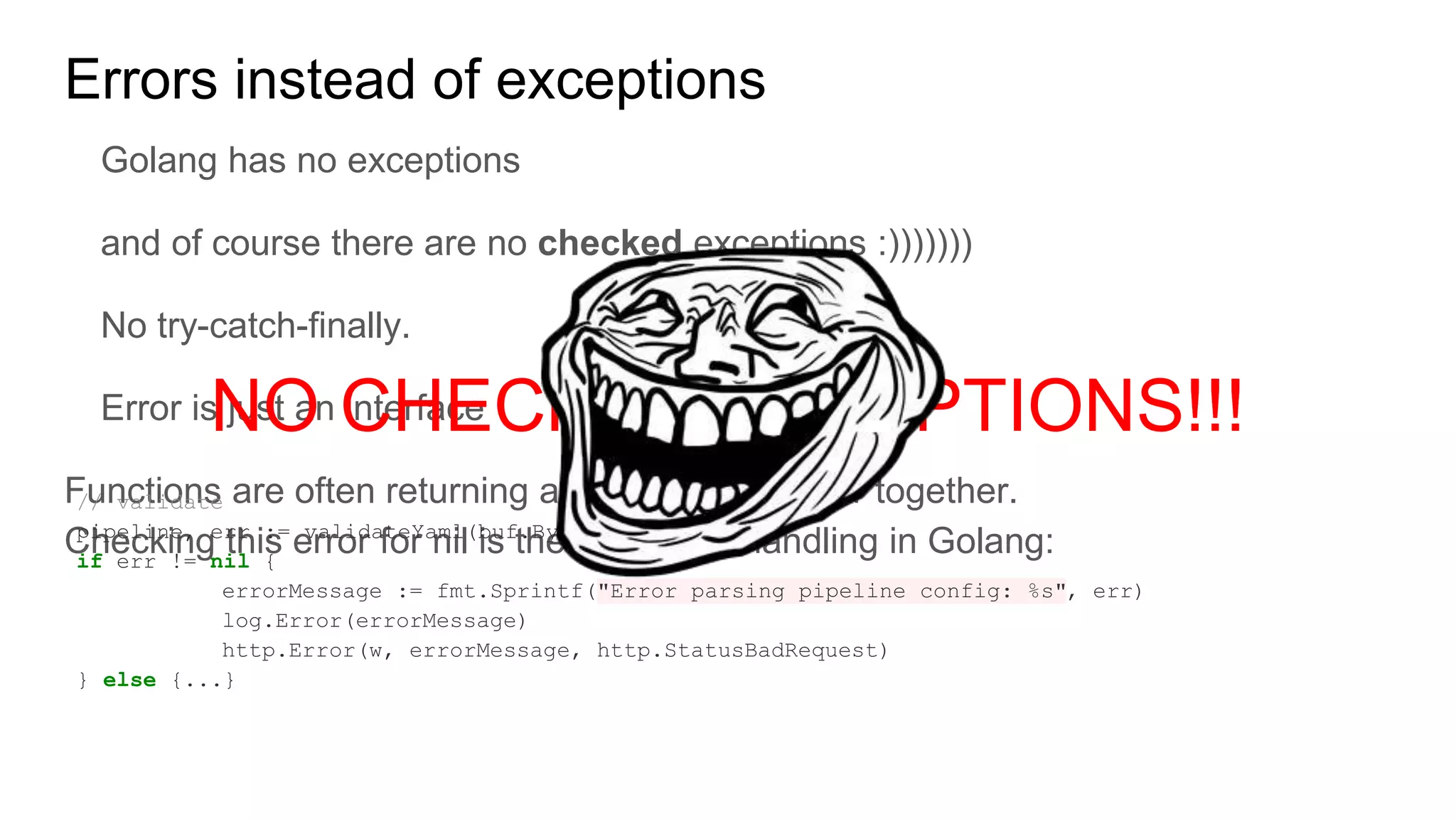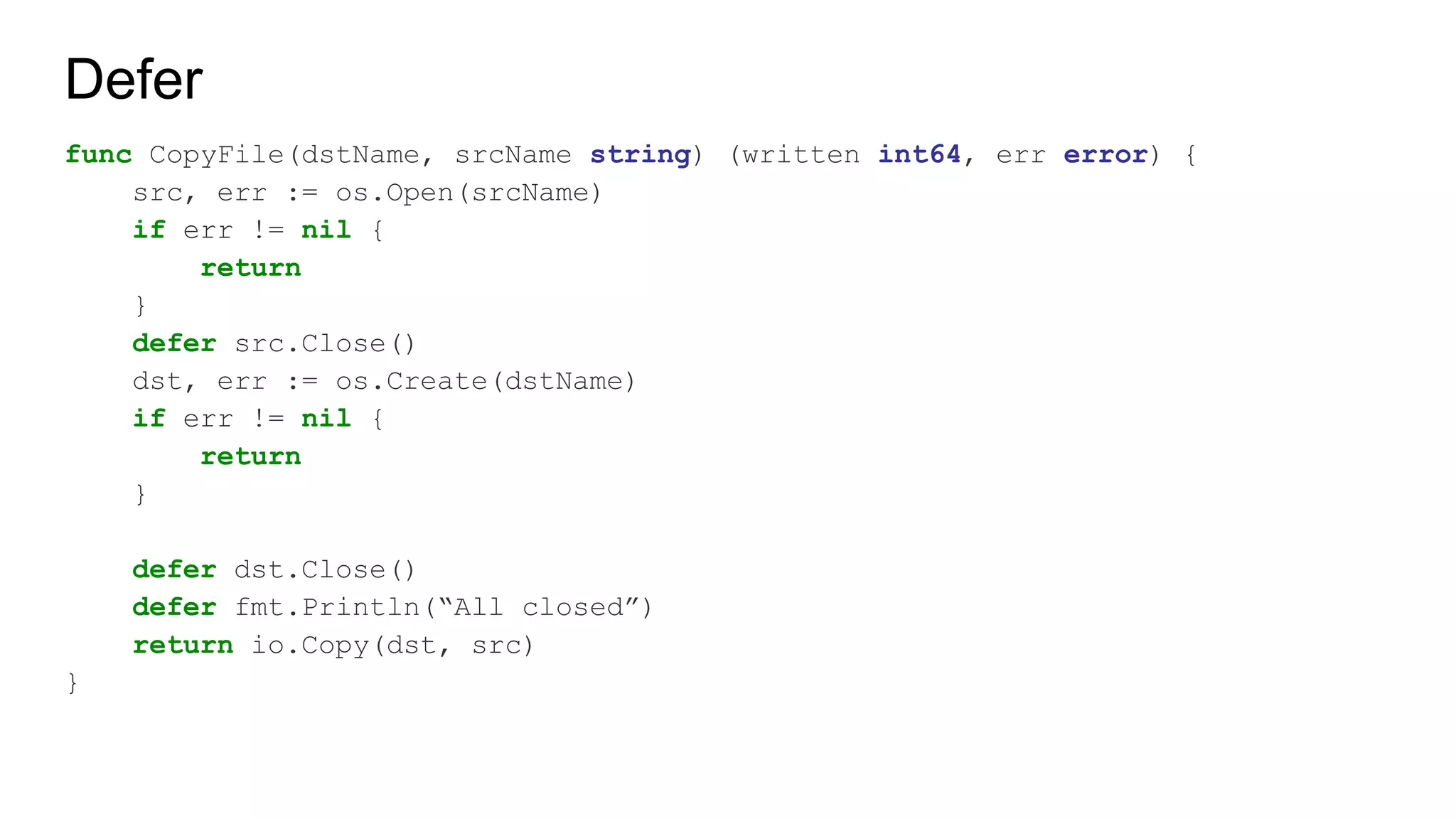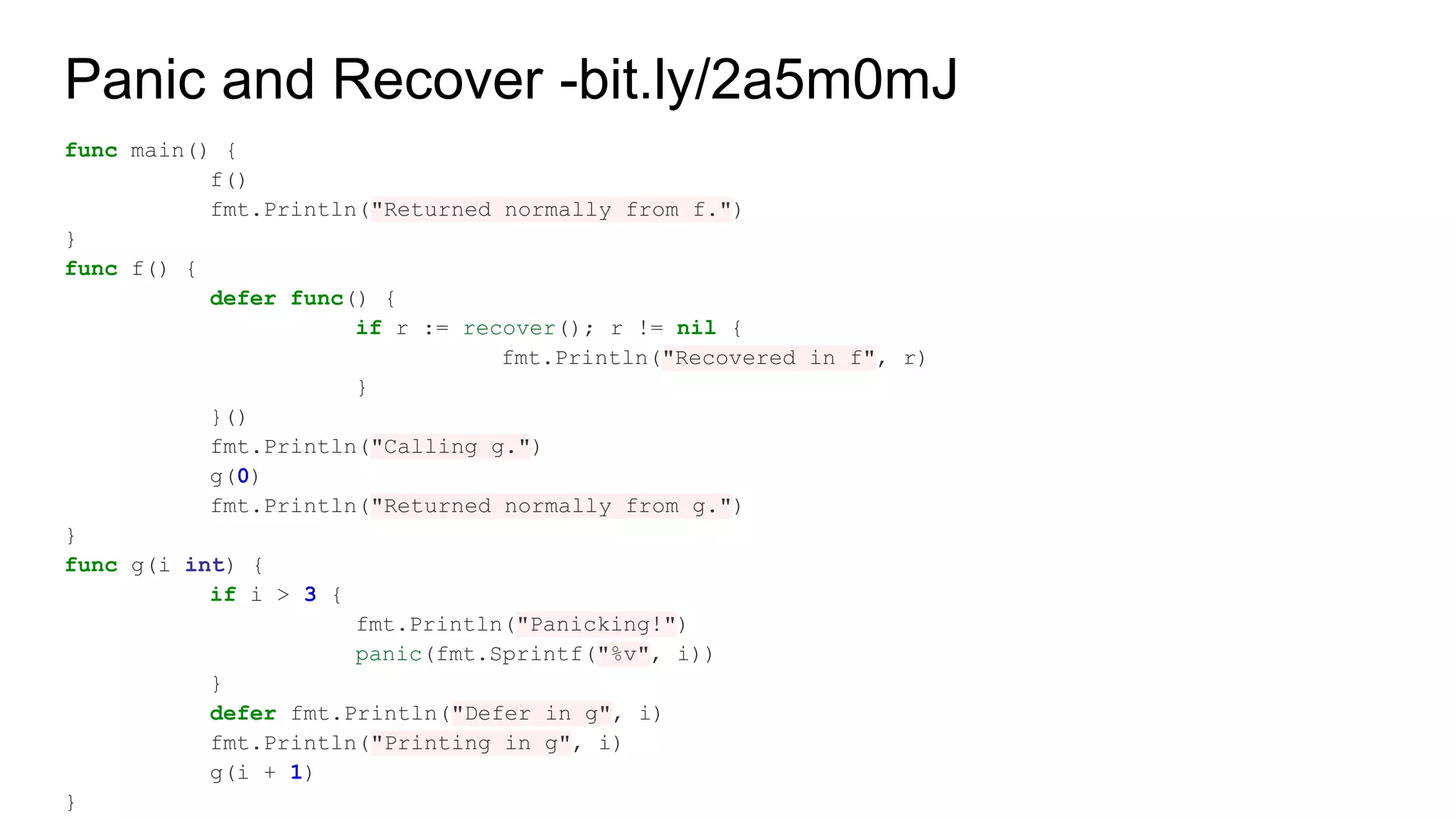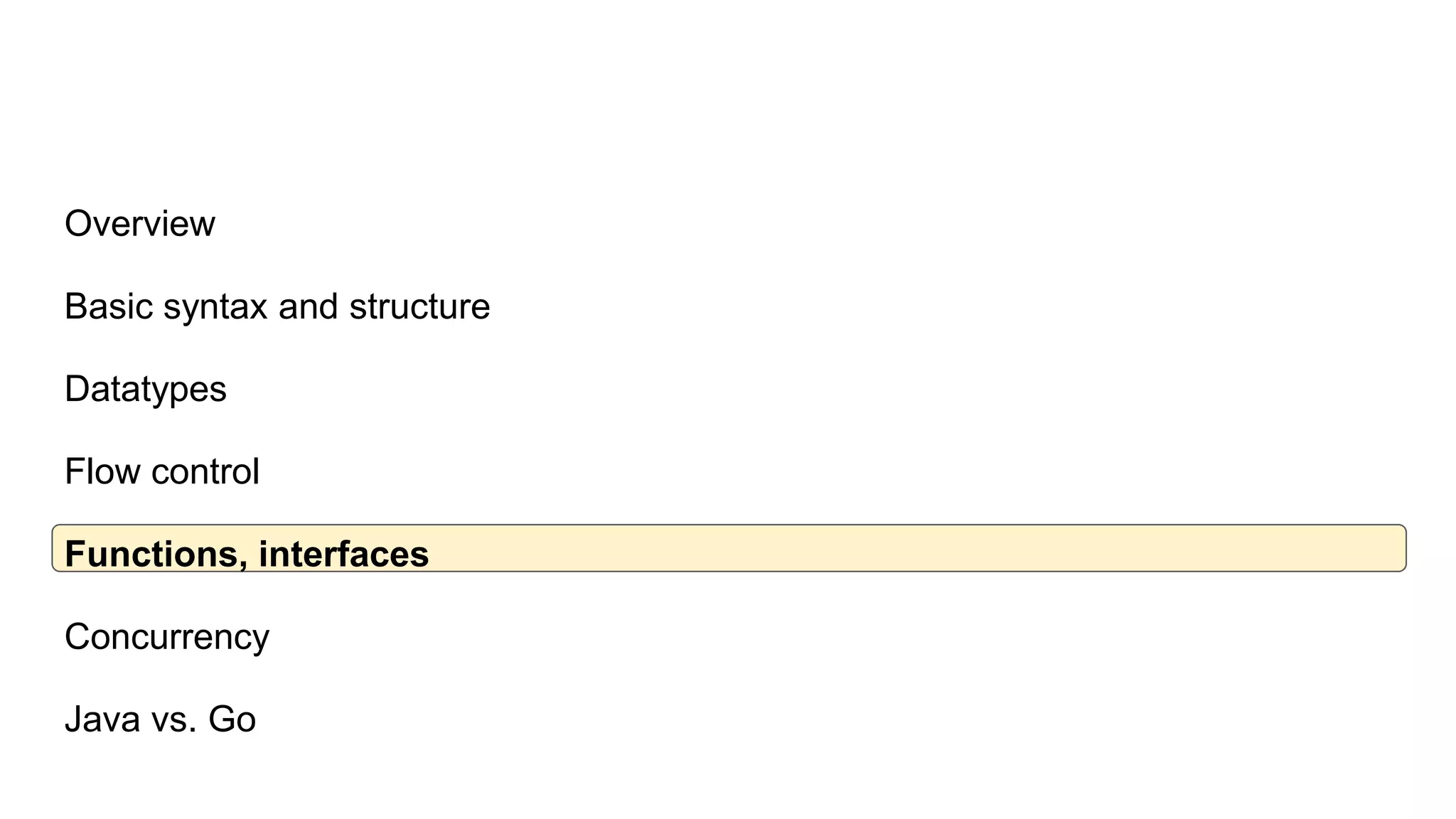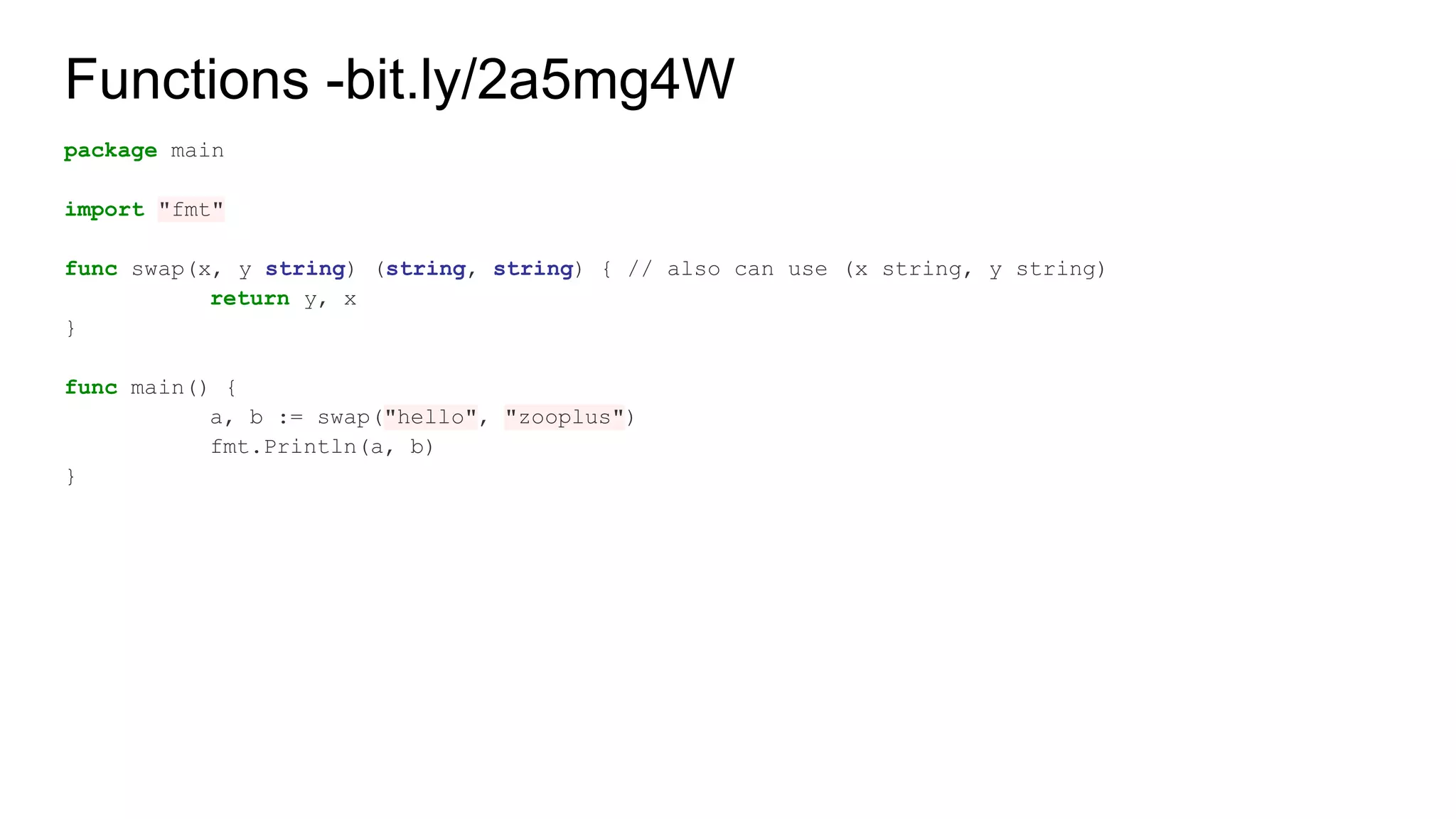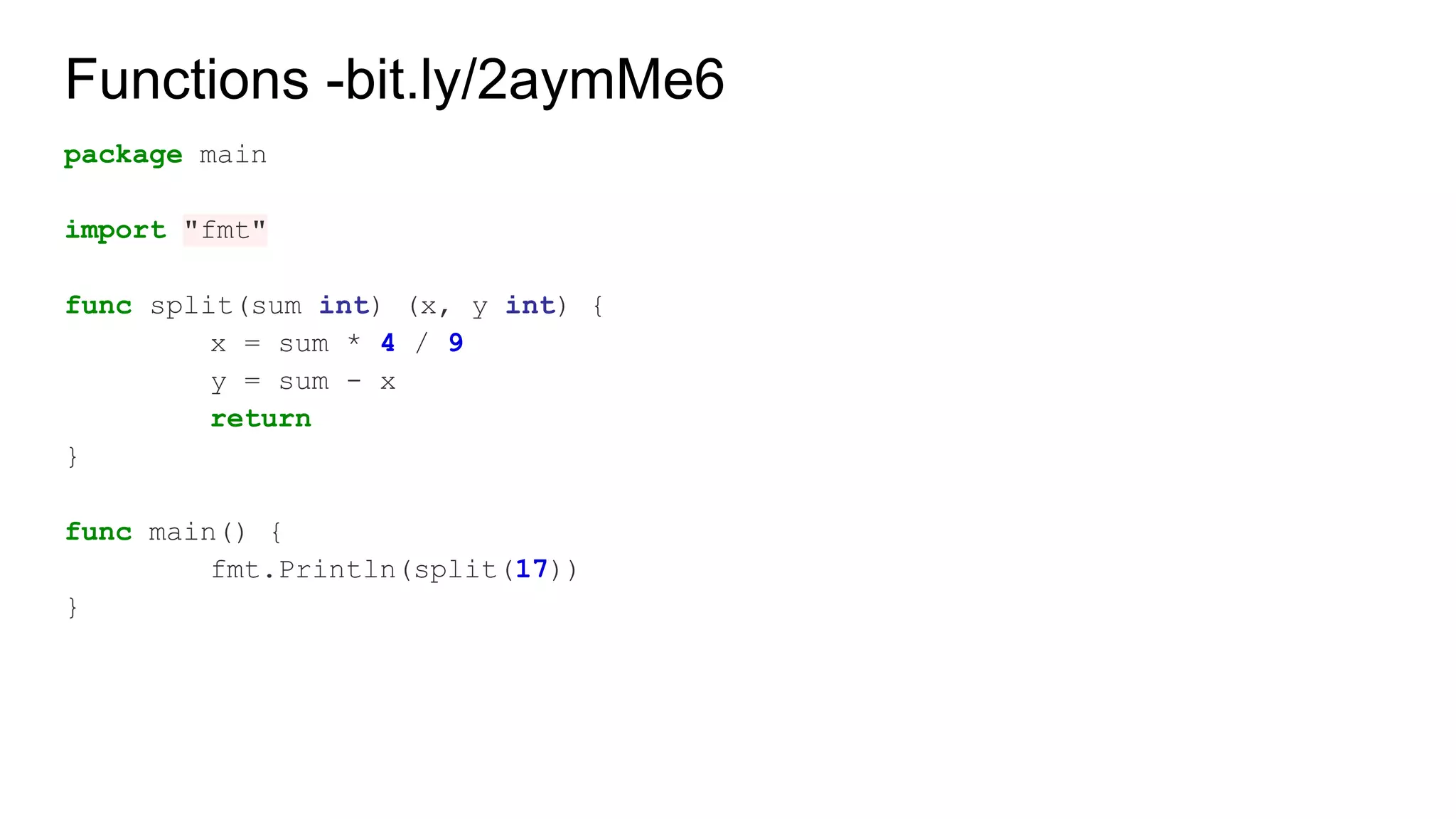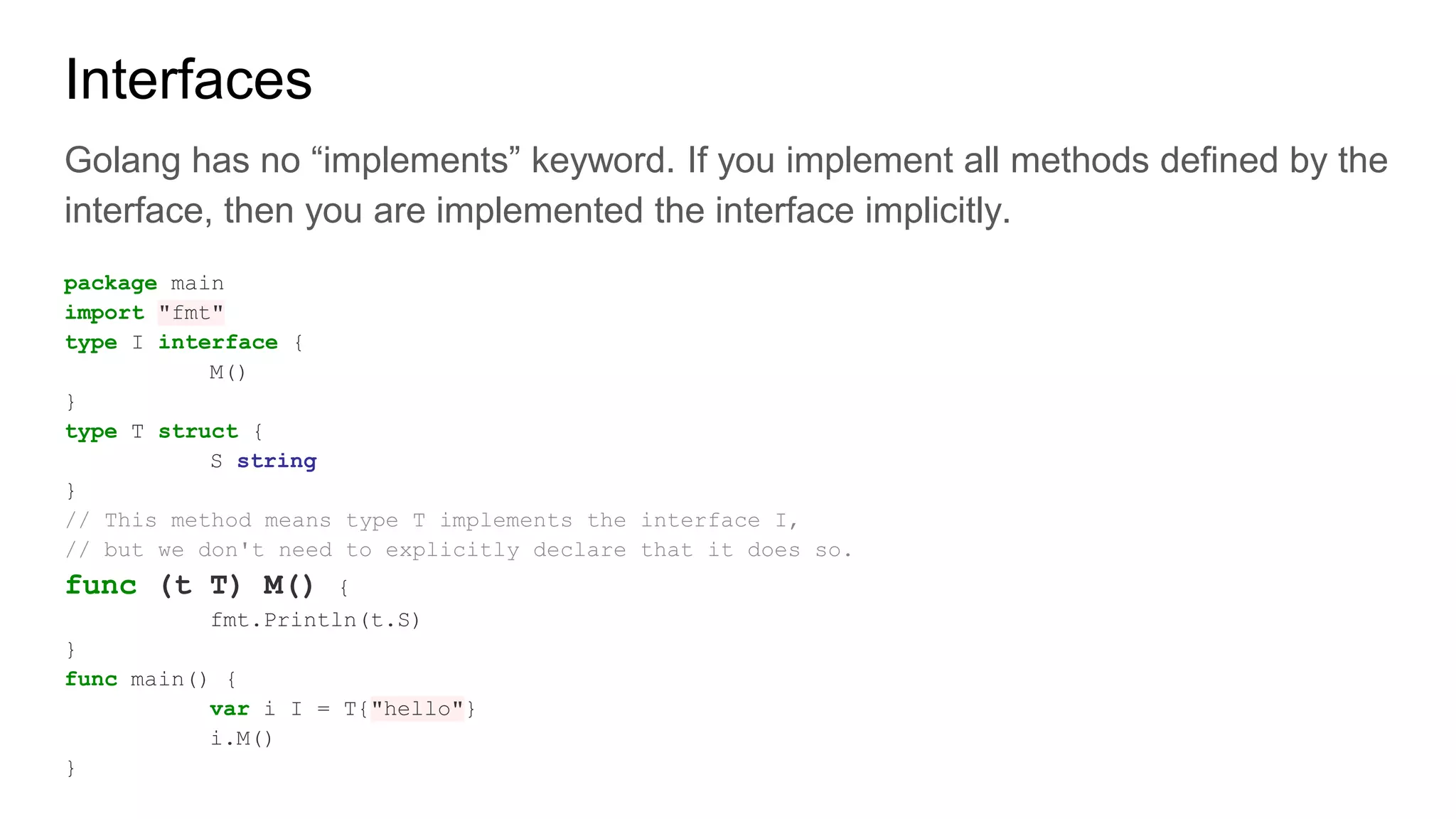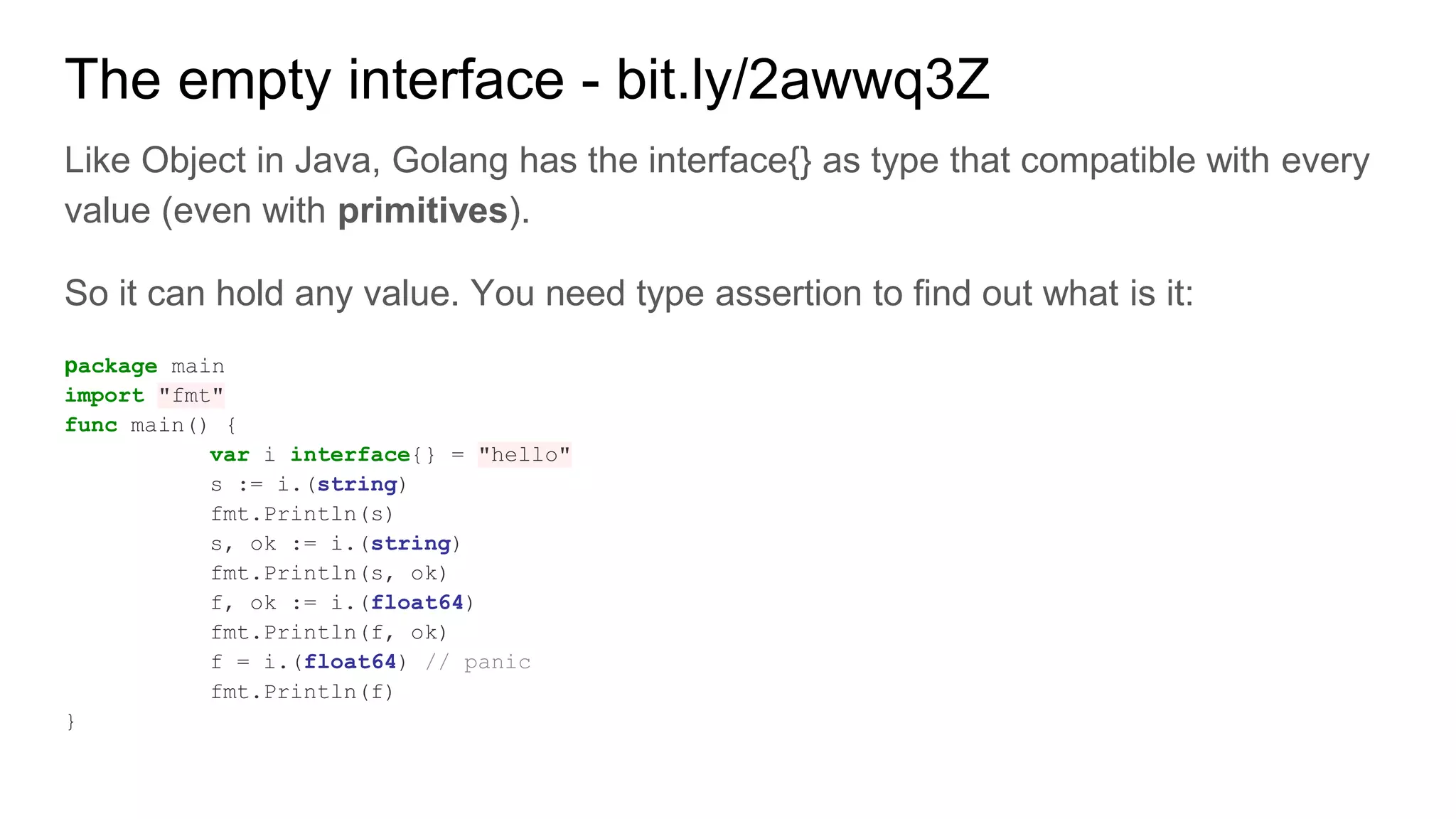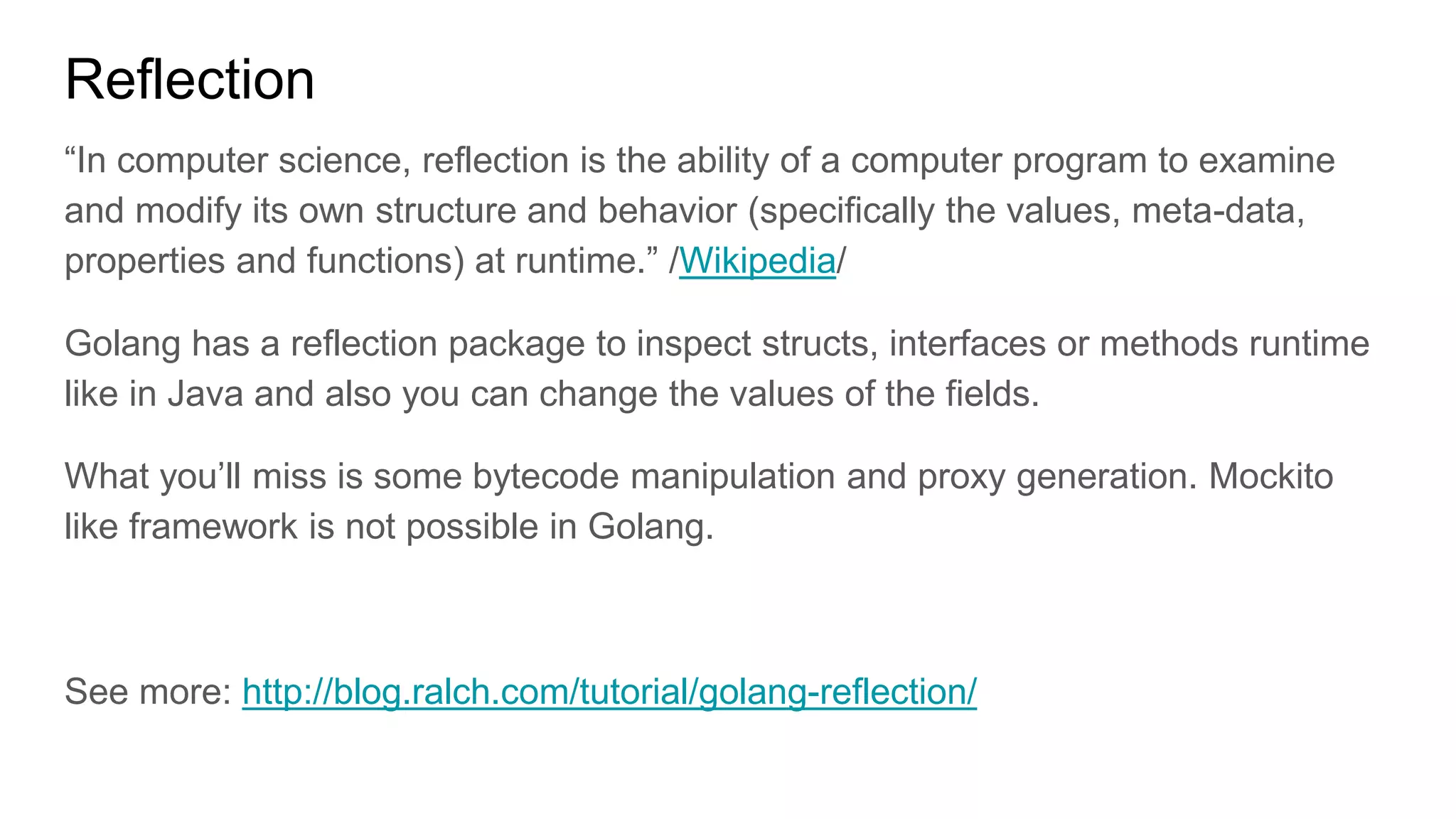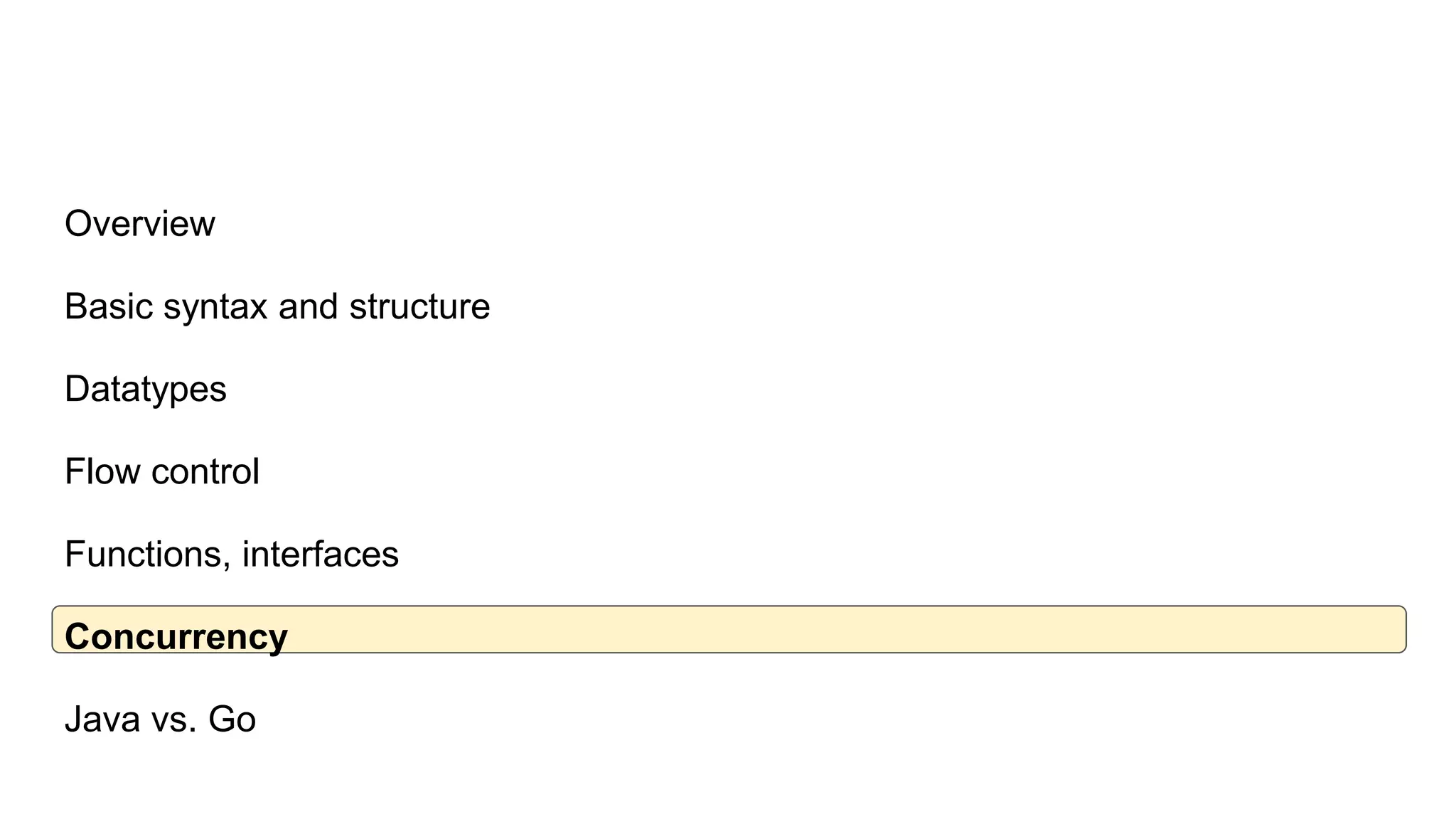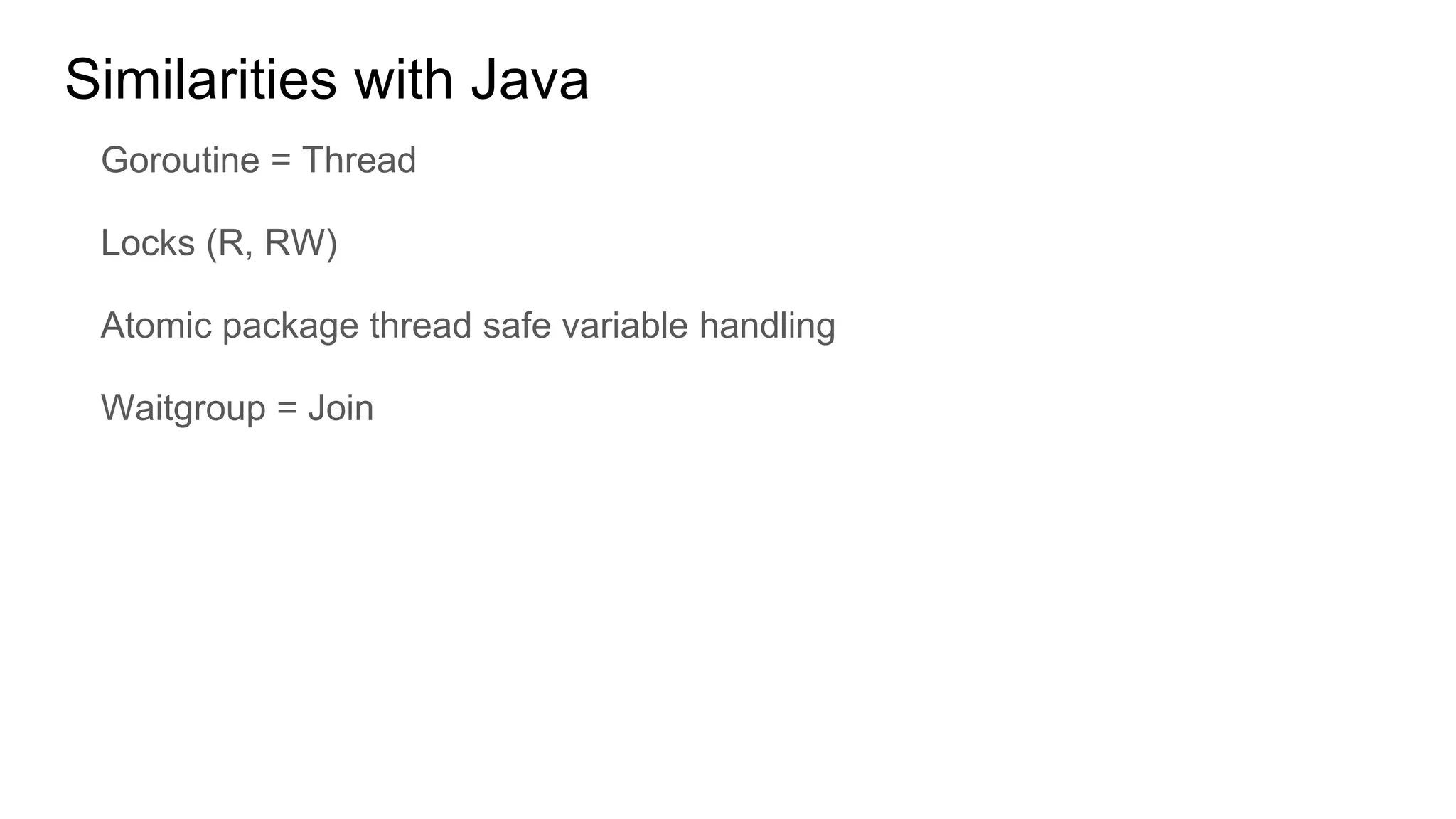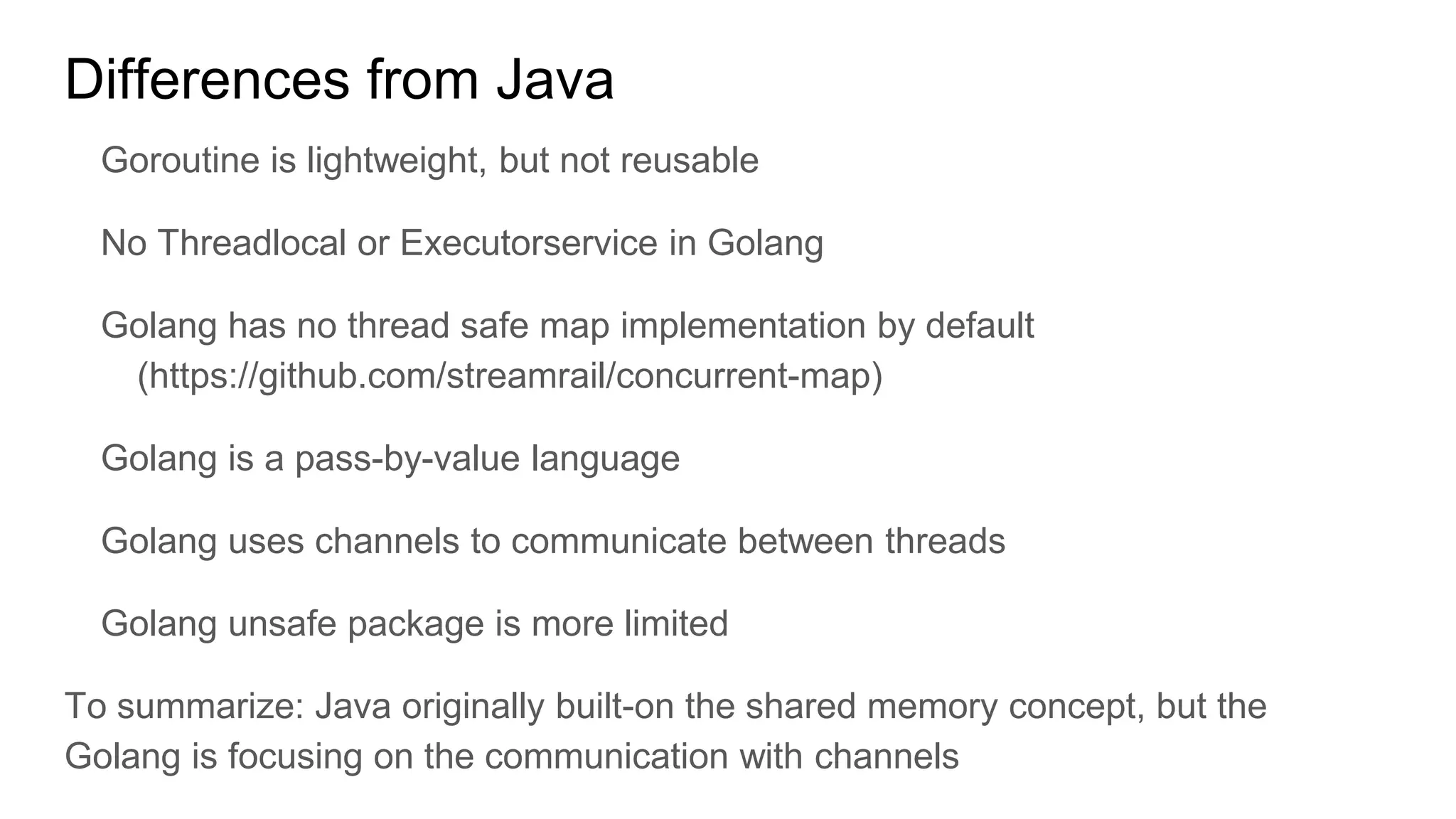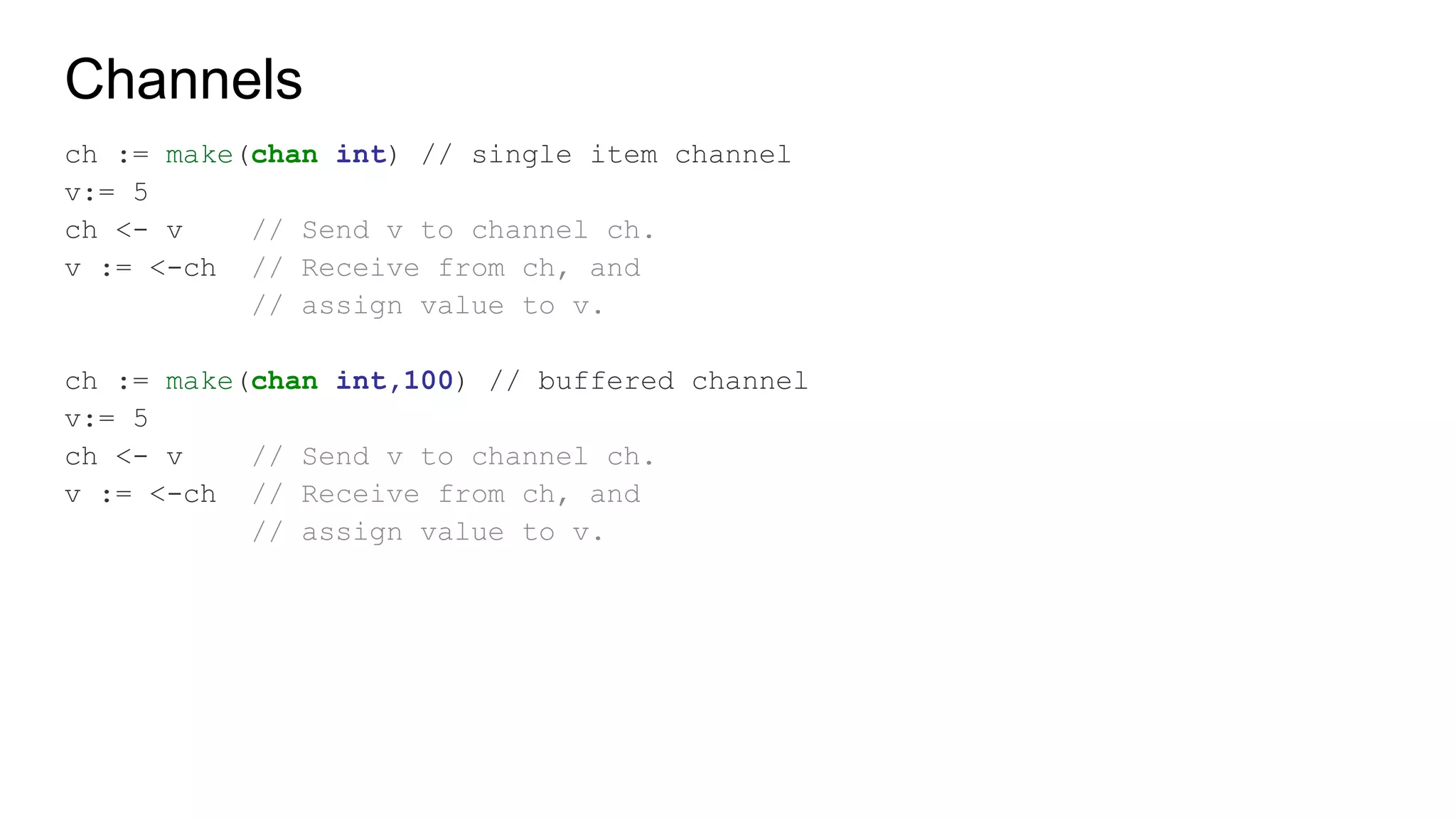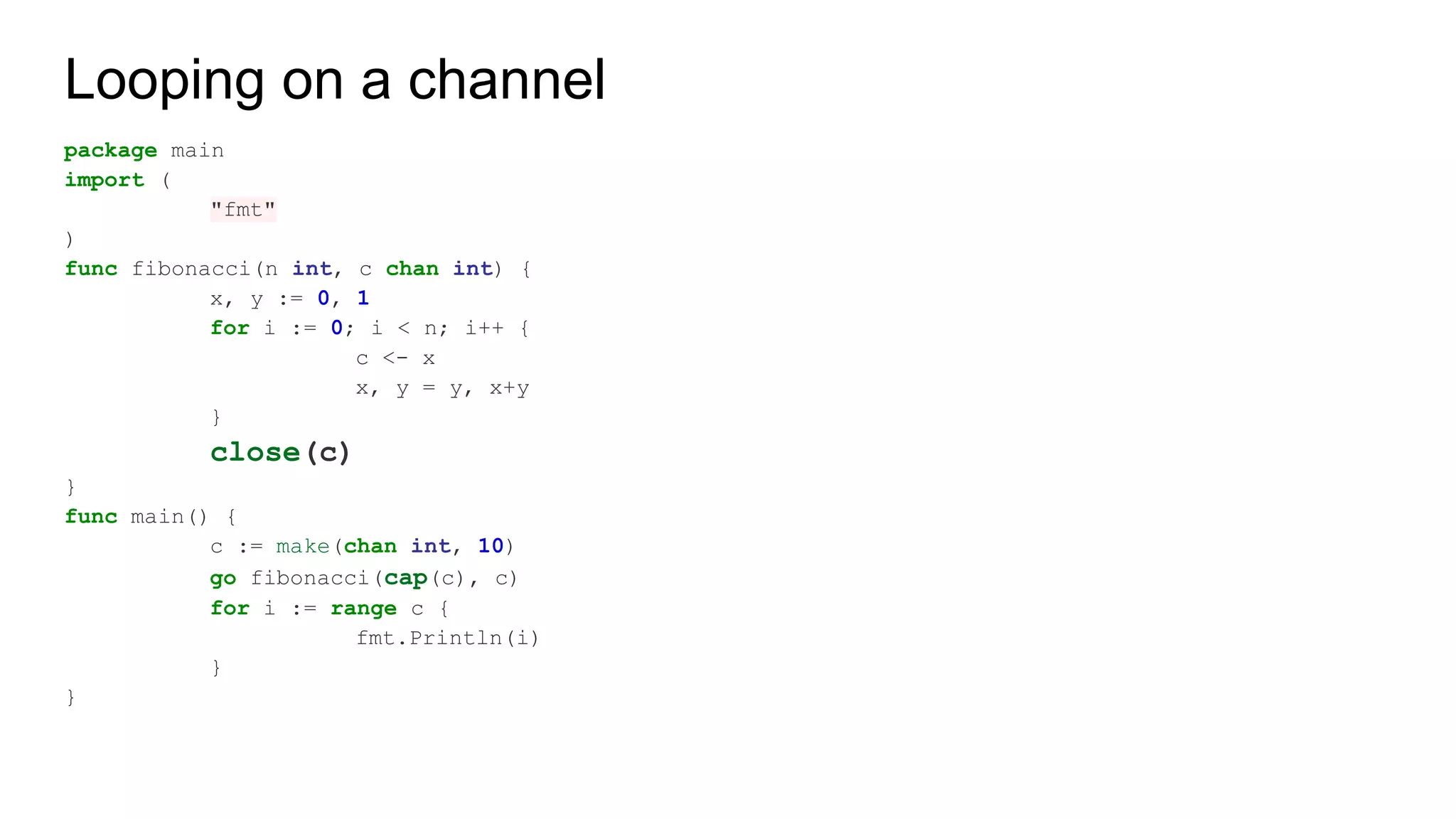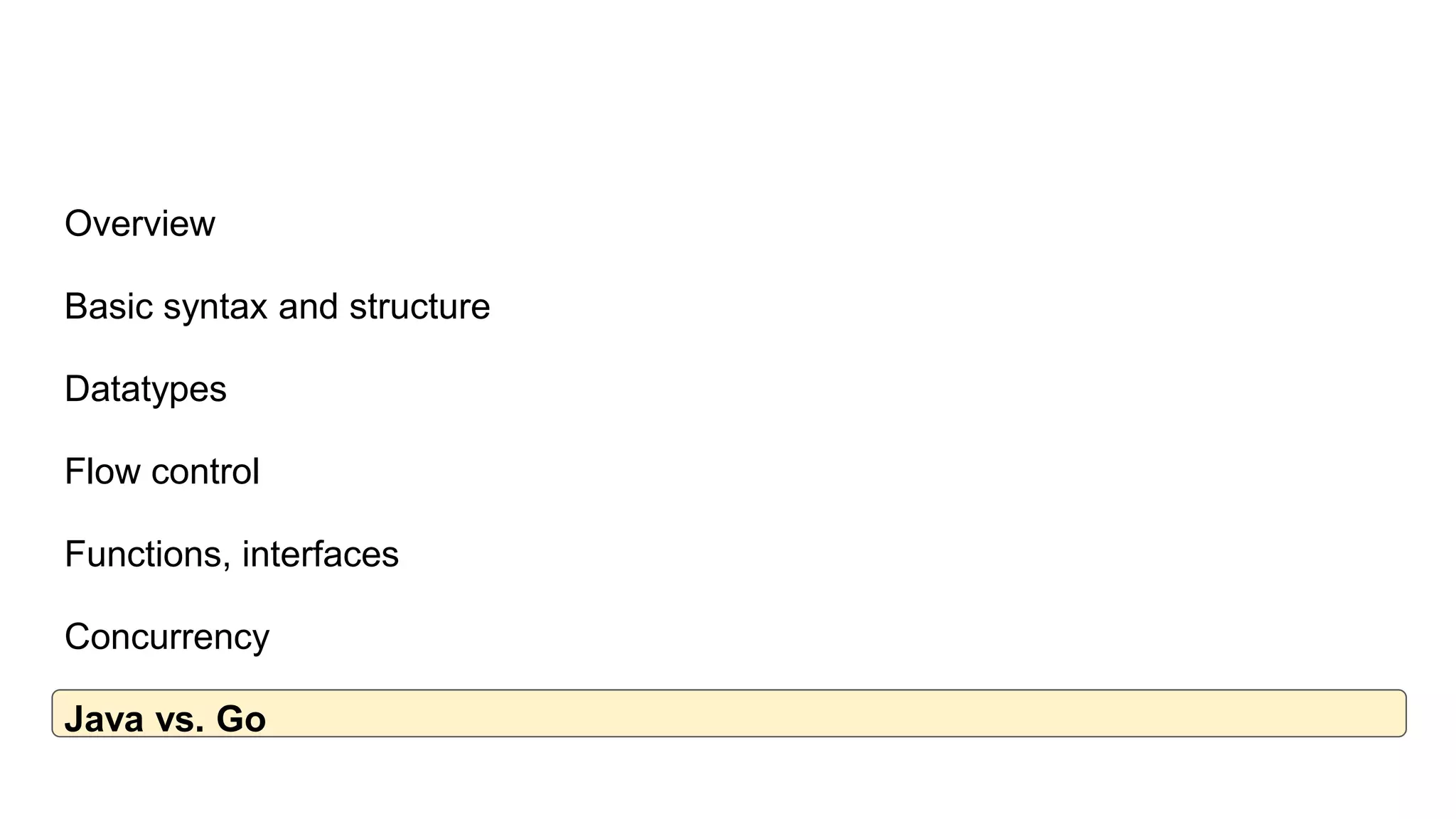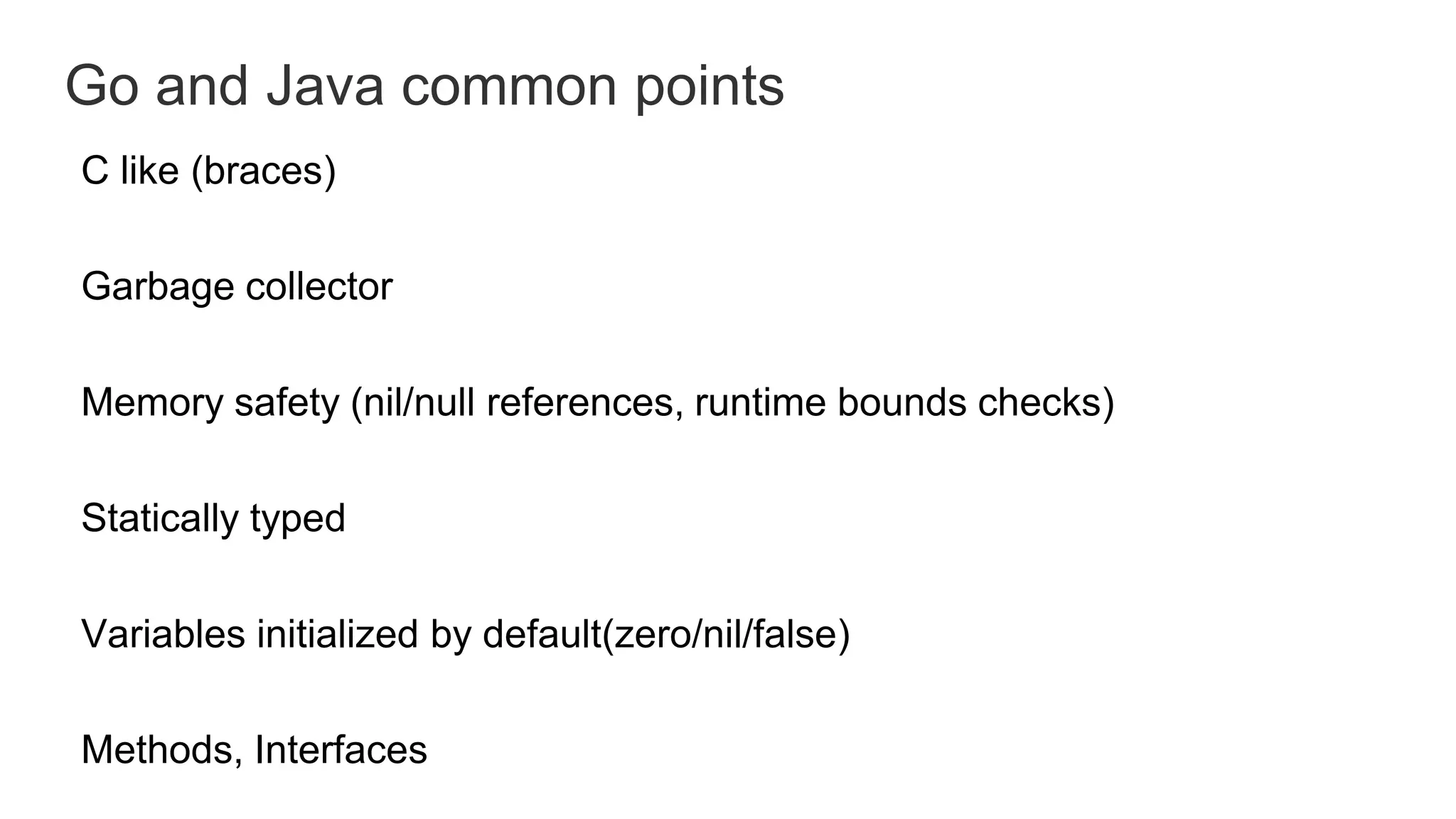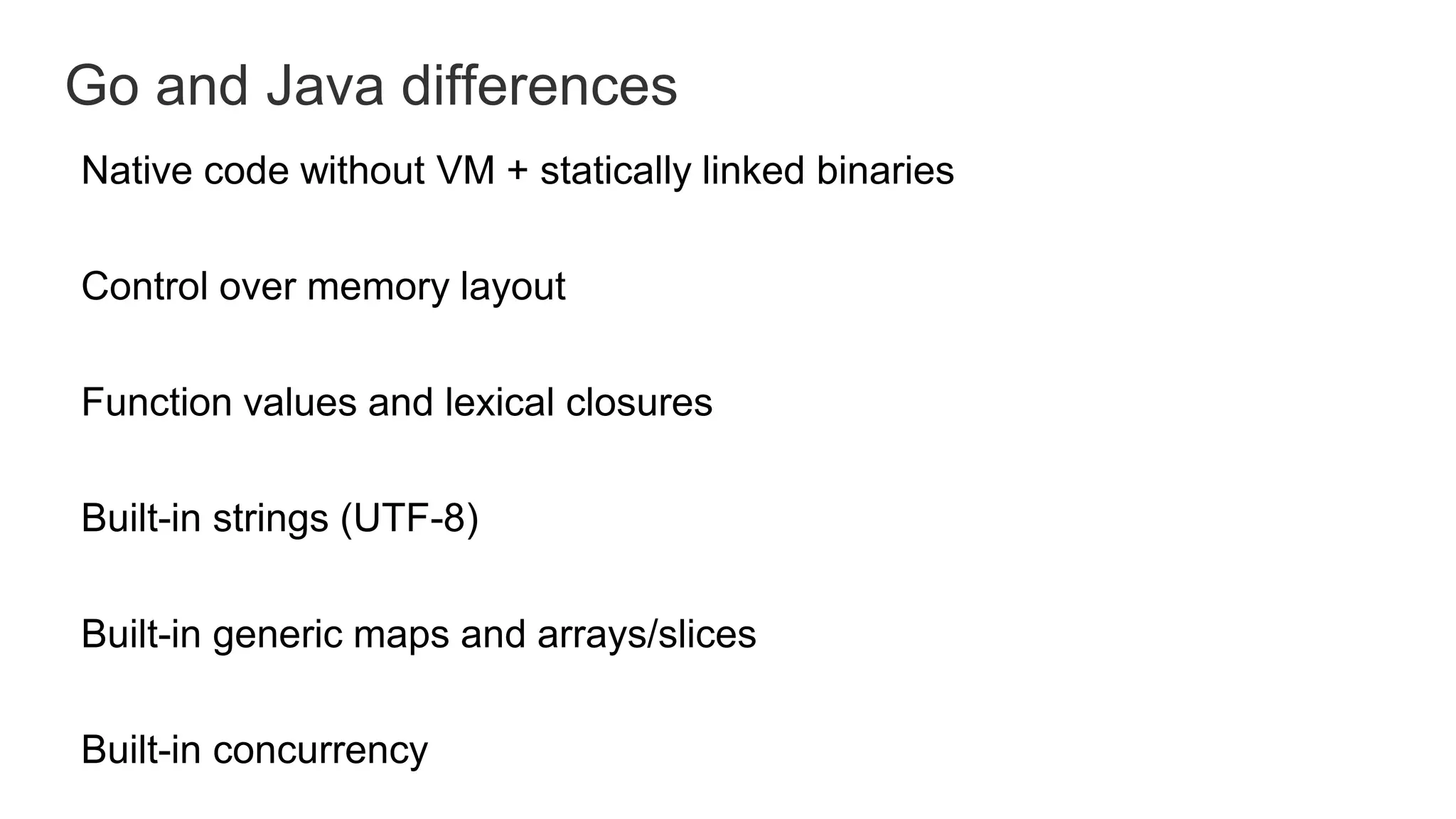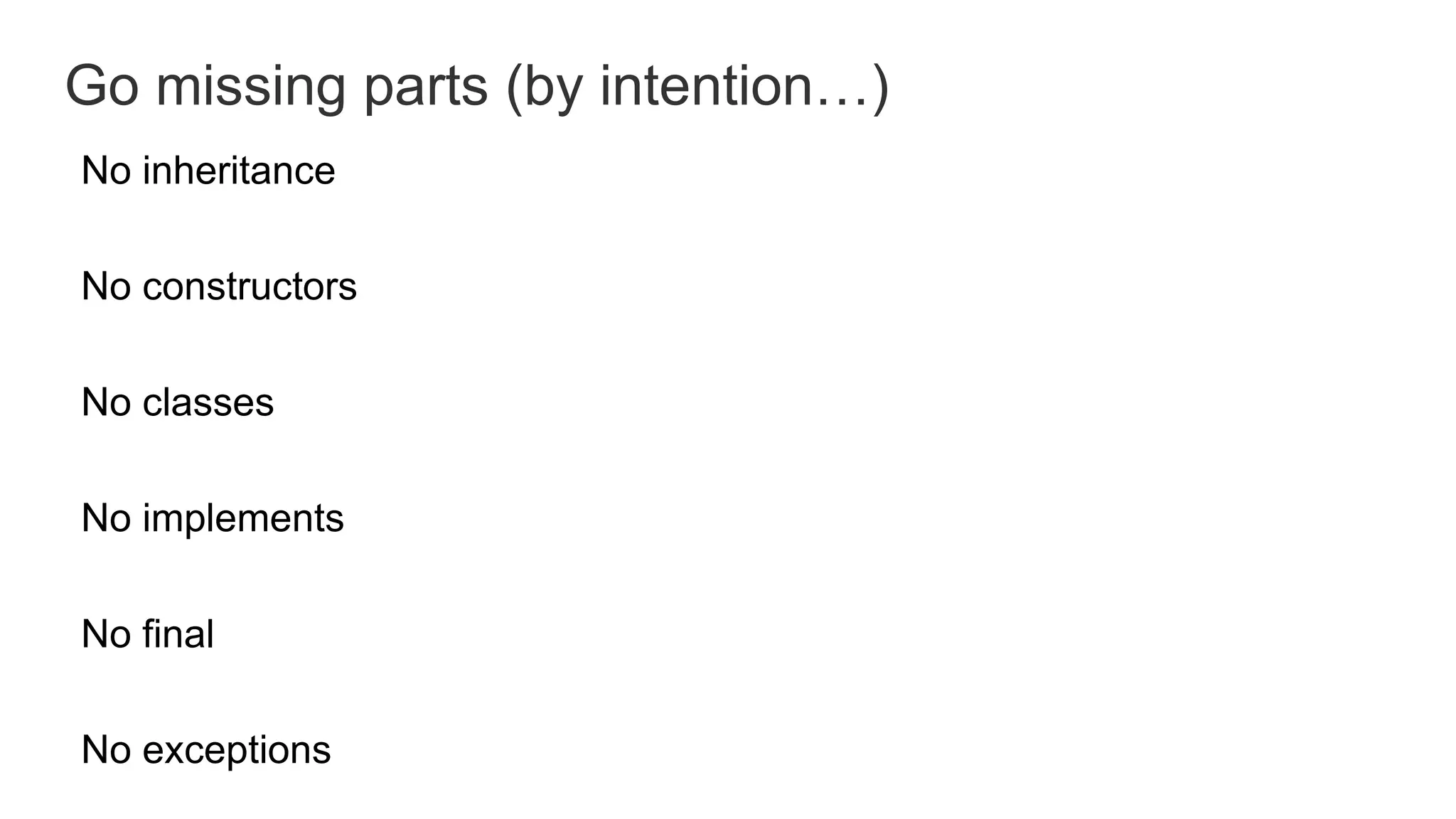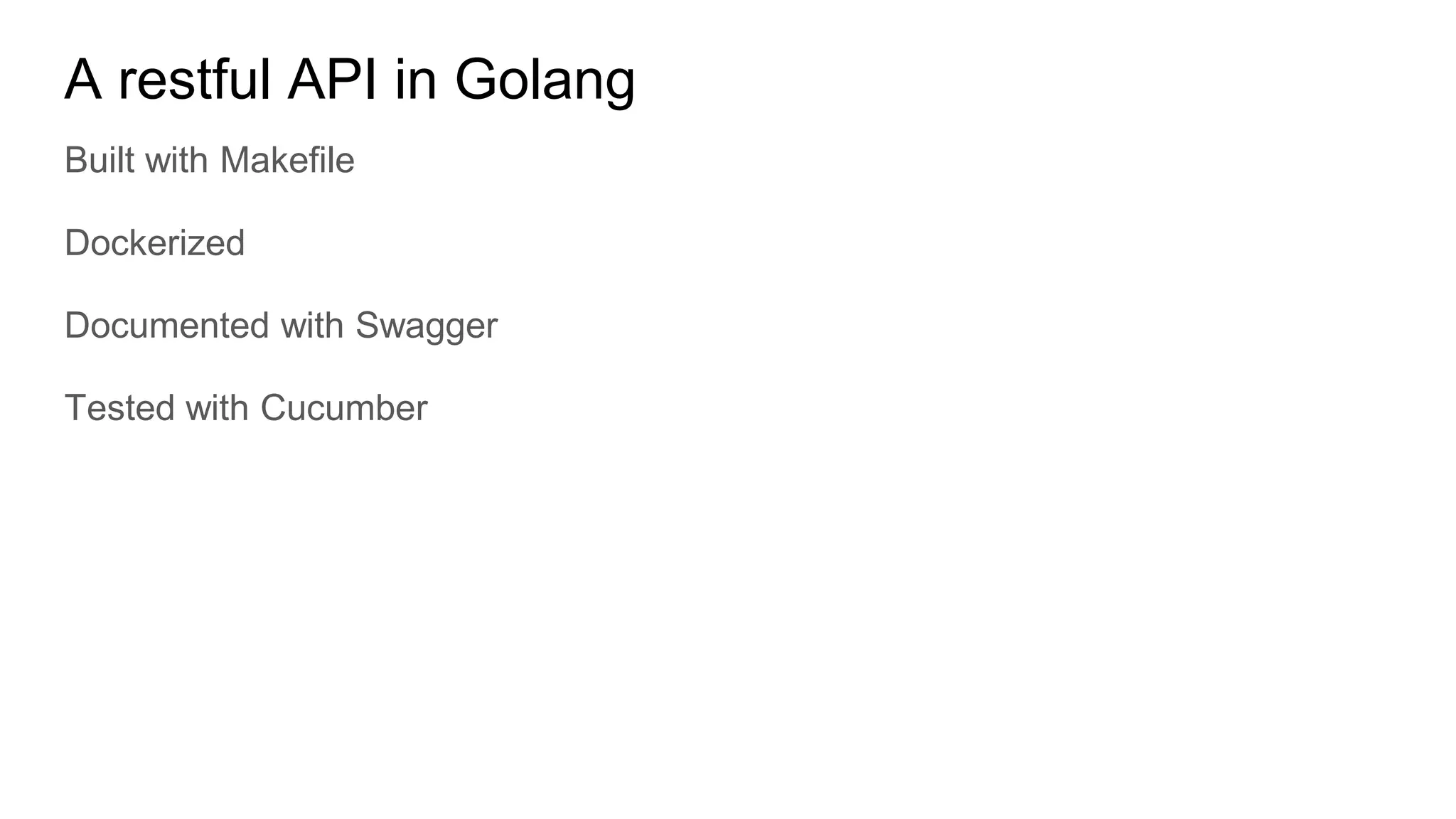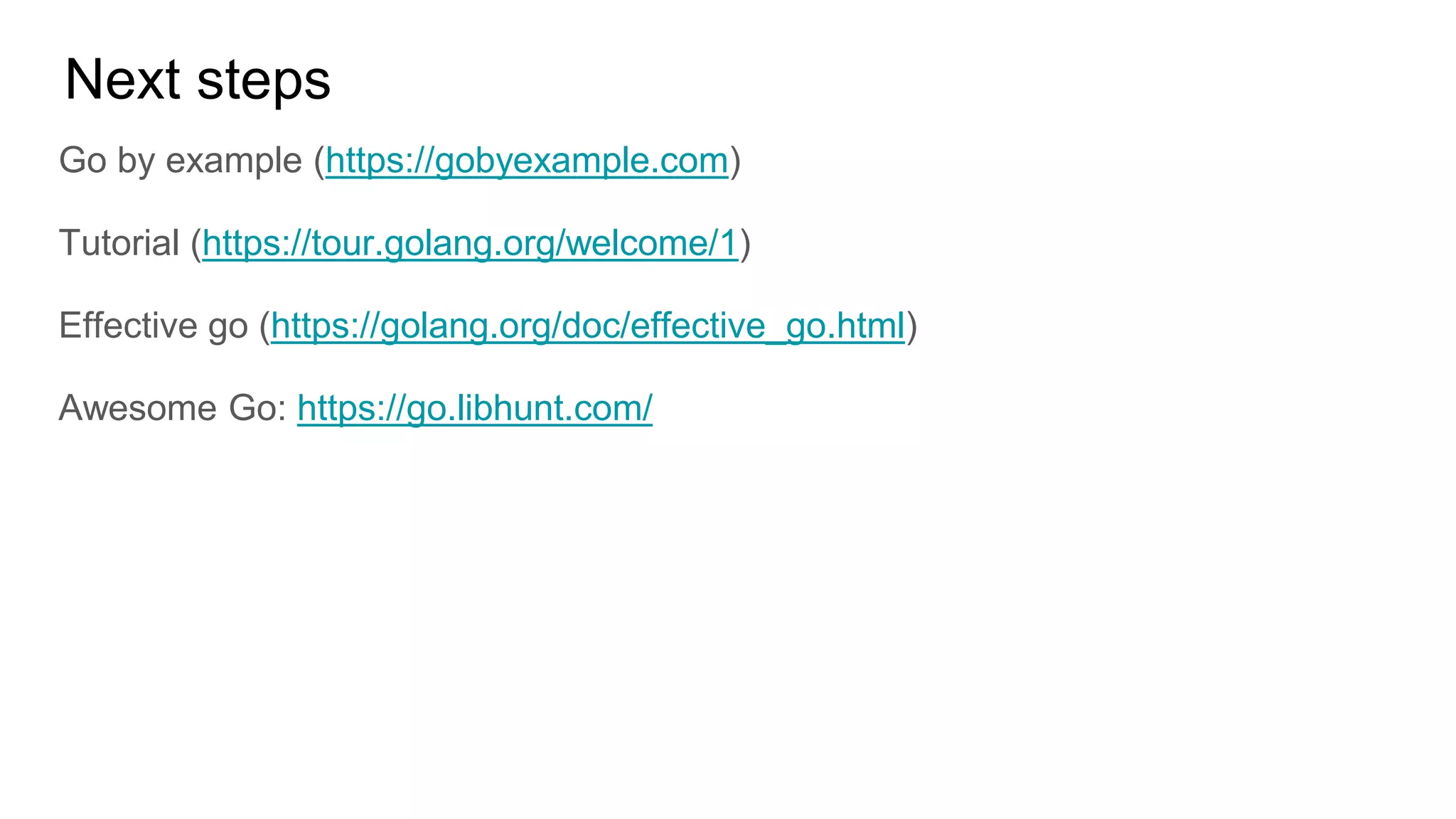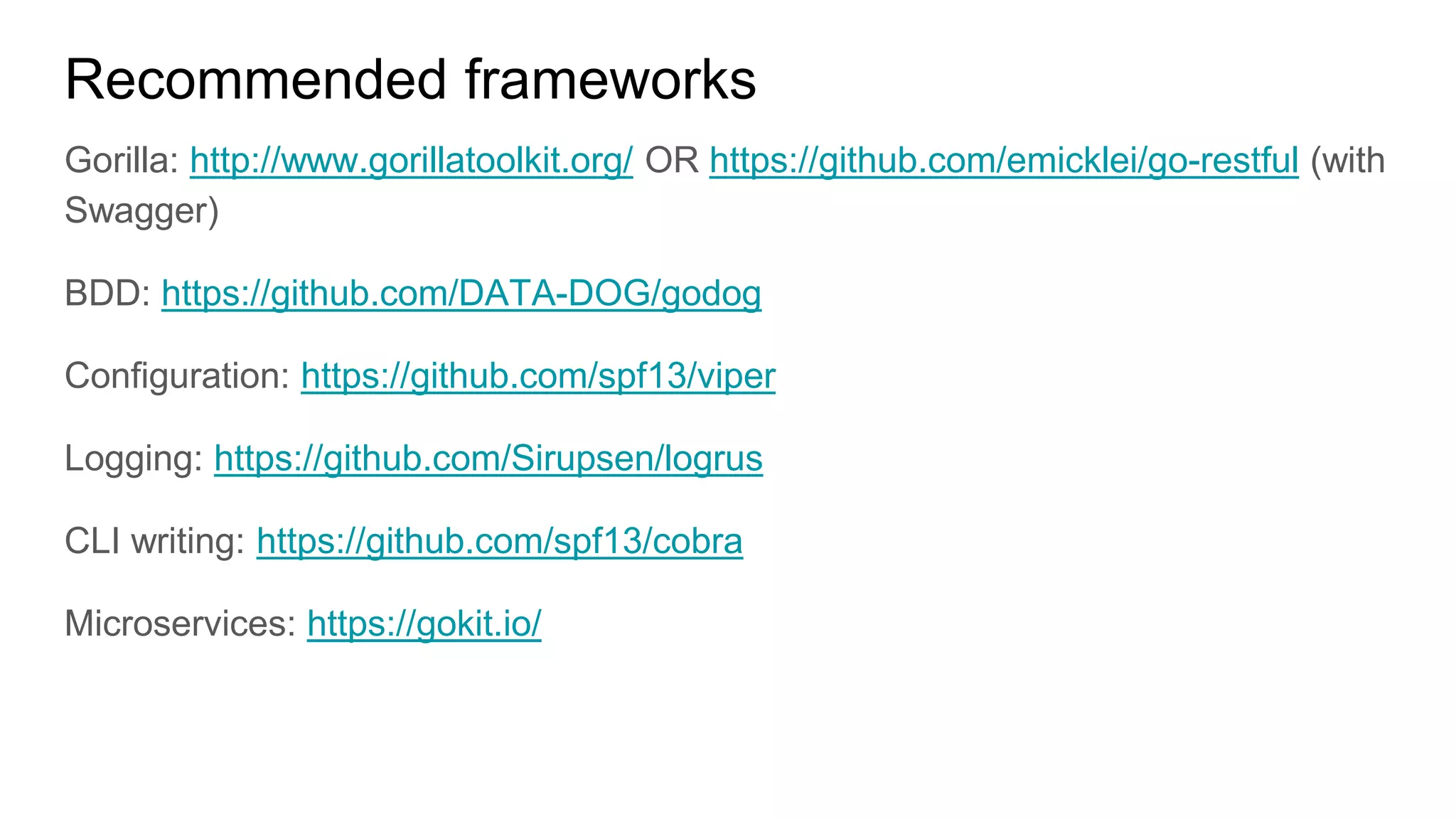This document provides an overview of Golang basics for Java developers. It covers Golang's history, features, syntax, data types, flow control, functions and interfaces, concurrency, and differences from Java. Key points include Golang being a compiled, statically typed language created at Google in 2007, its use of packages and imports, basic types like strings and integers, slices for dynamic arrays, maps for key-value pairs, functions with receivers, errors instead of exceptions, and goroutines for concurrency with channels.

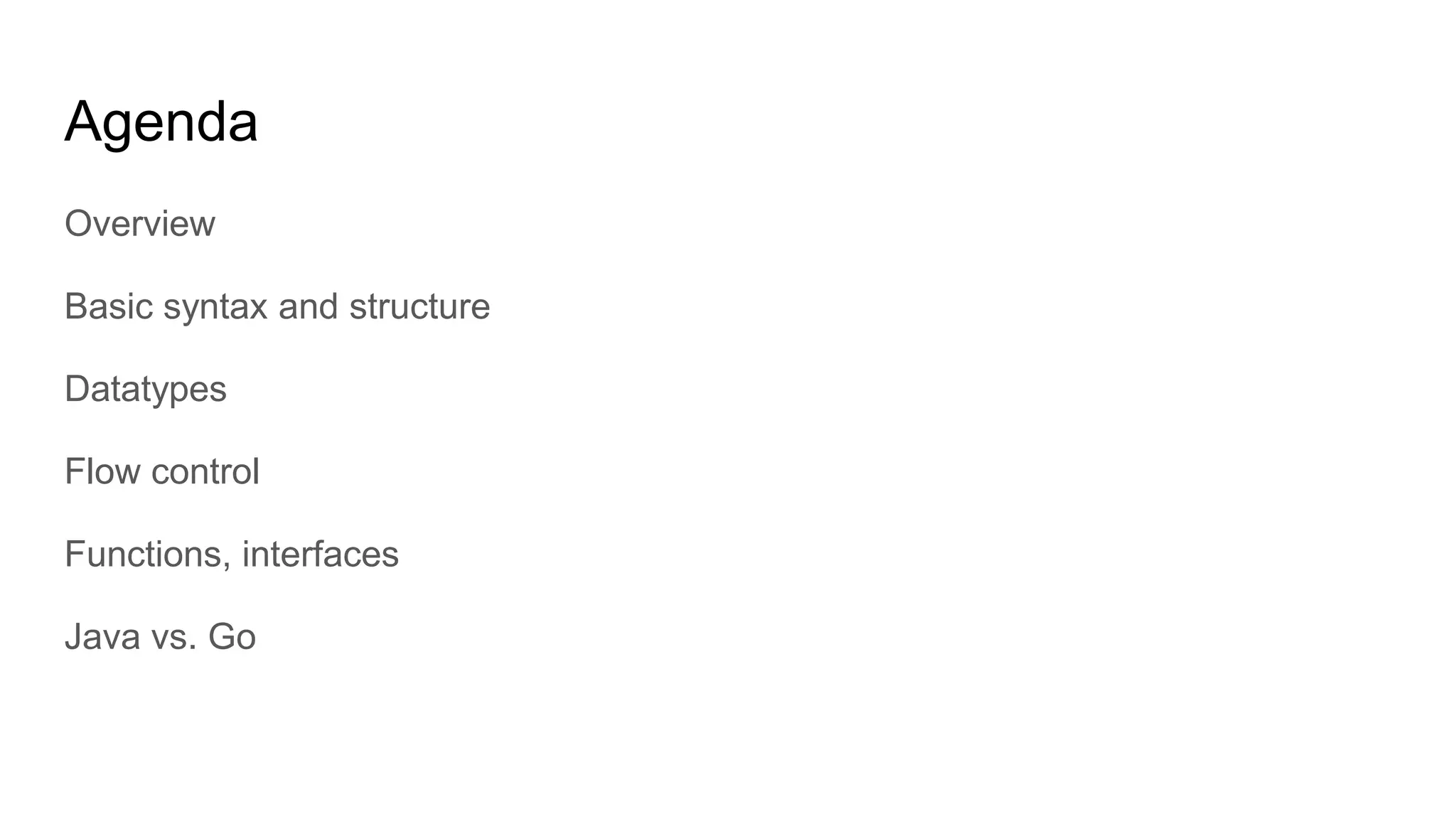

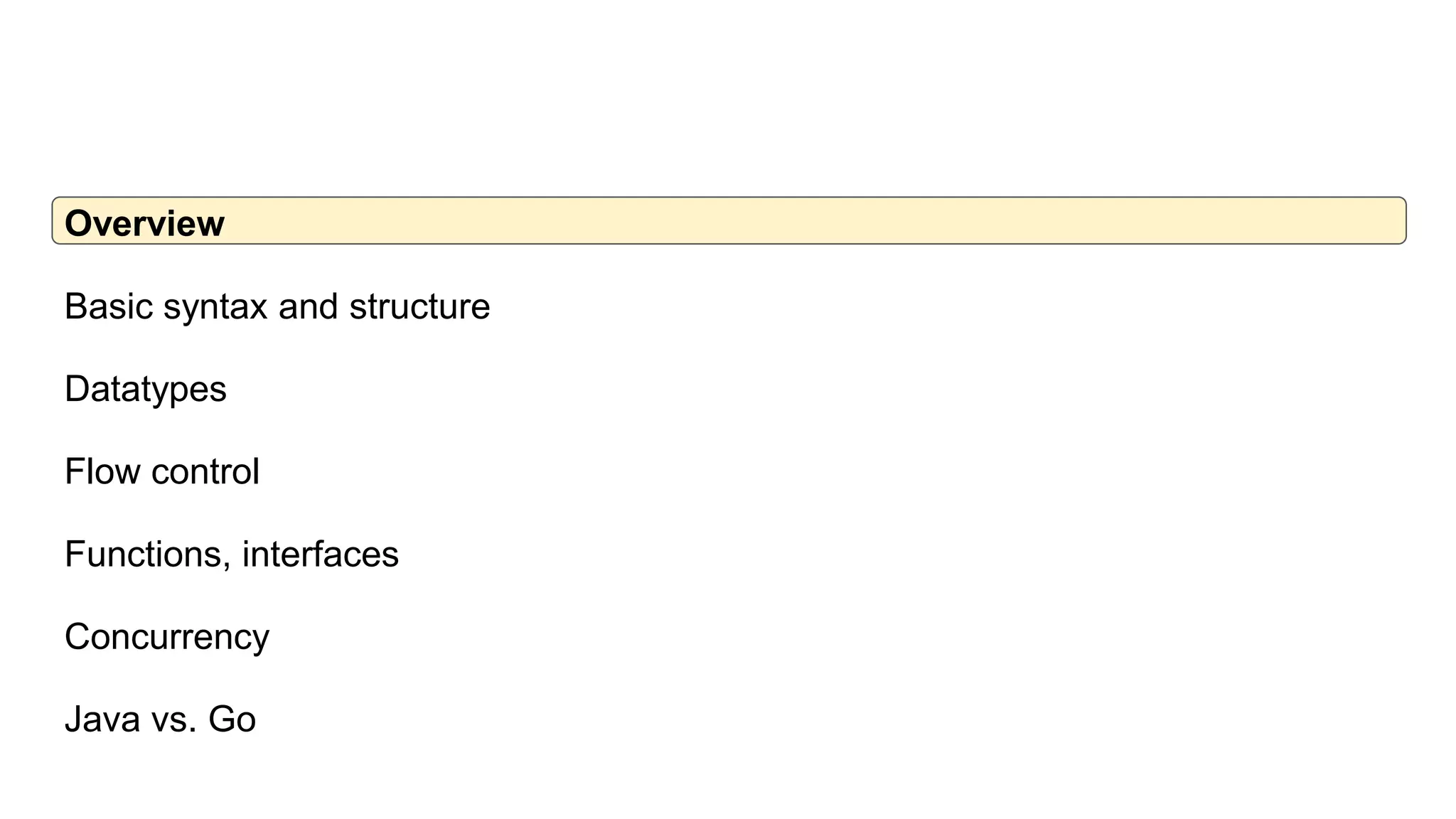
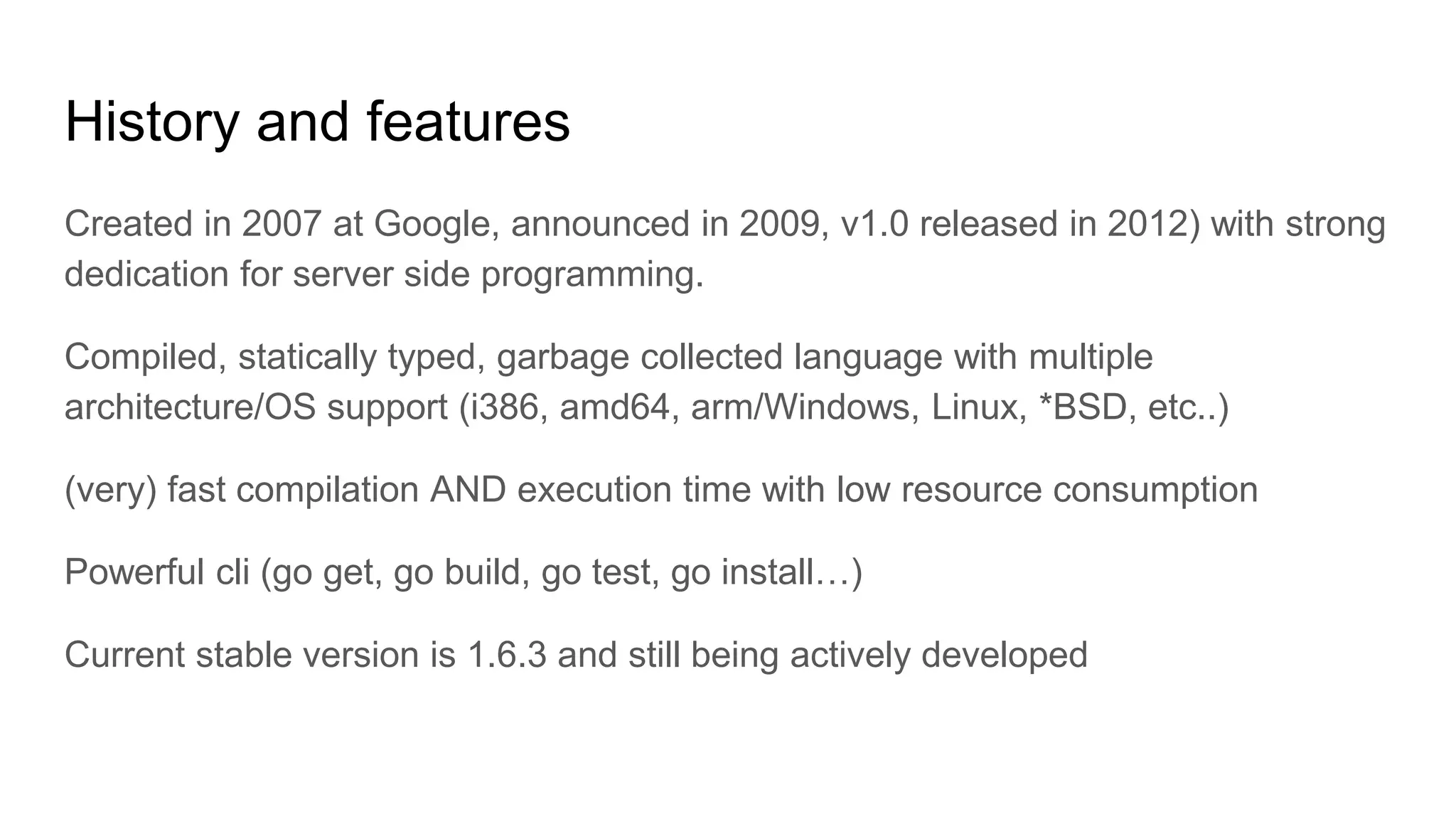
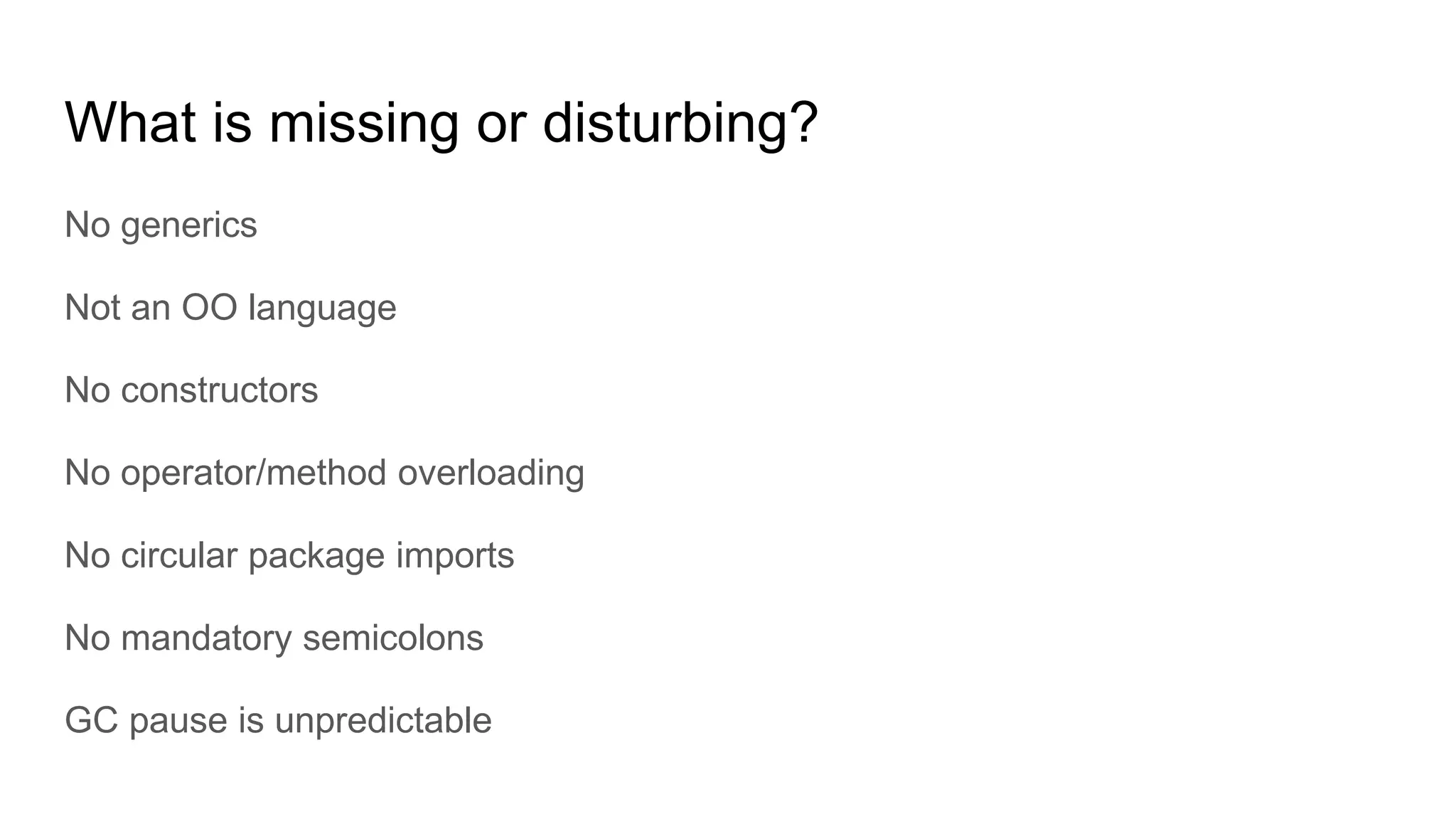
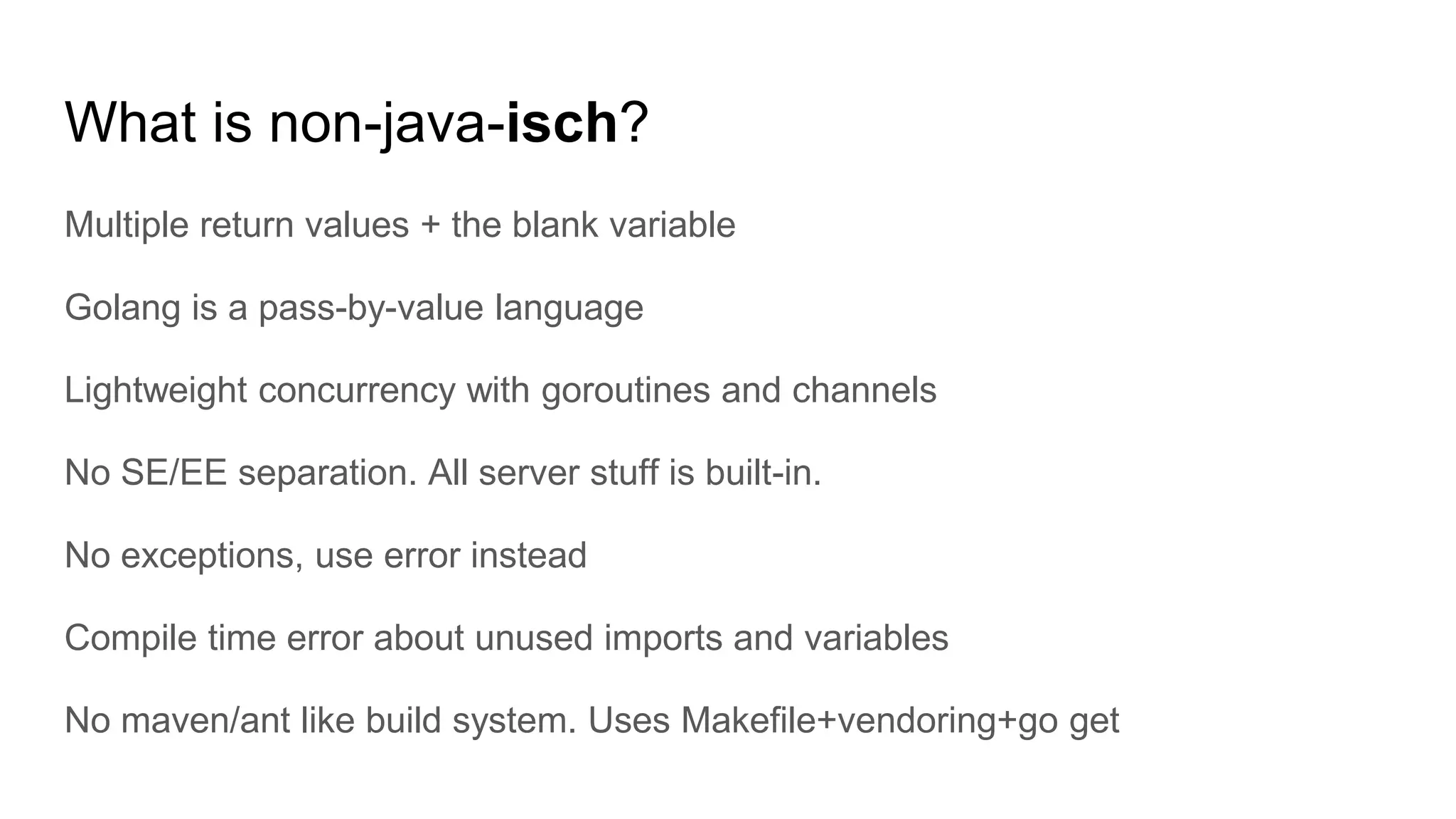
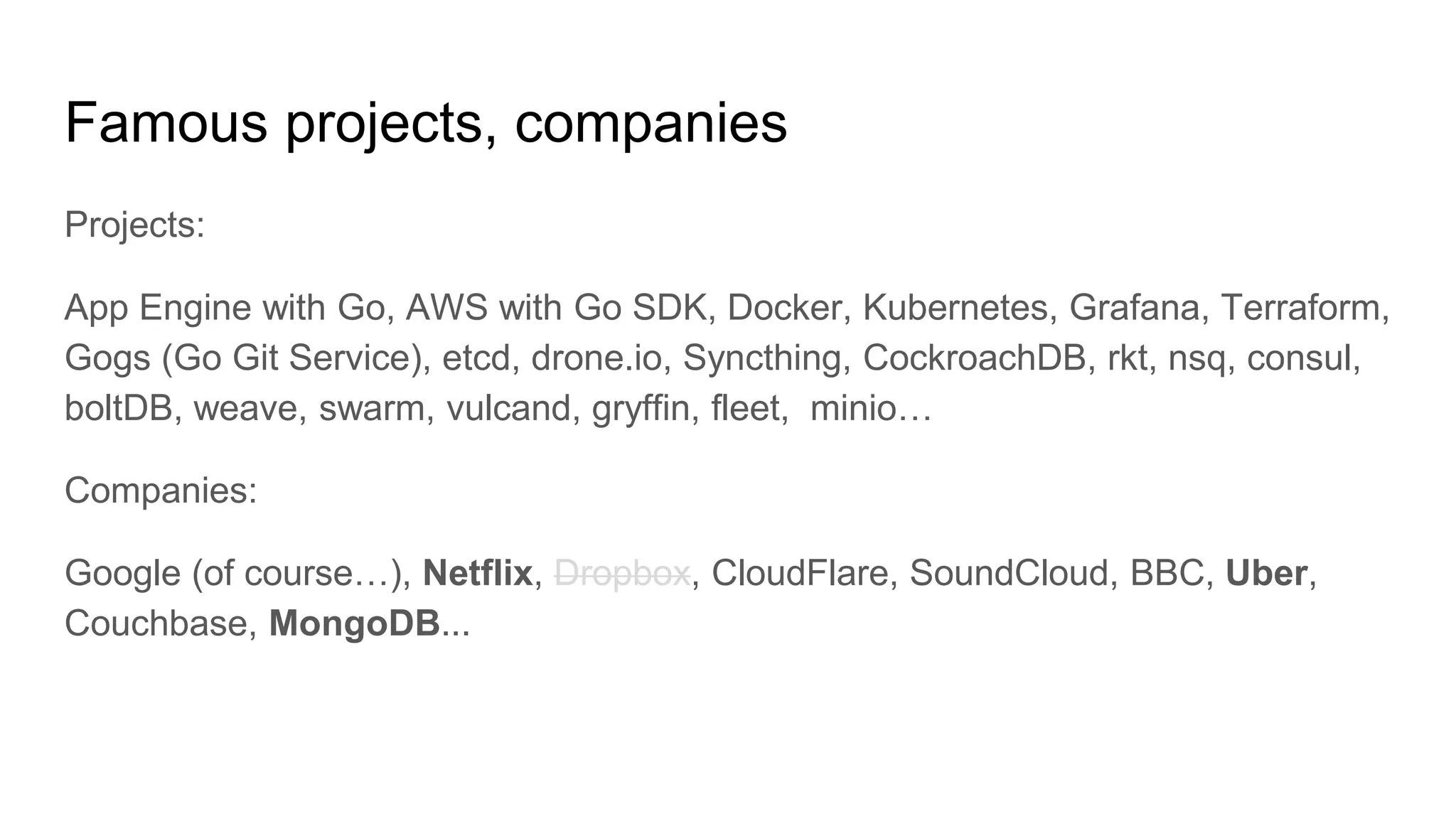


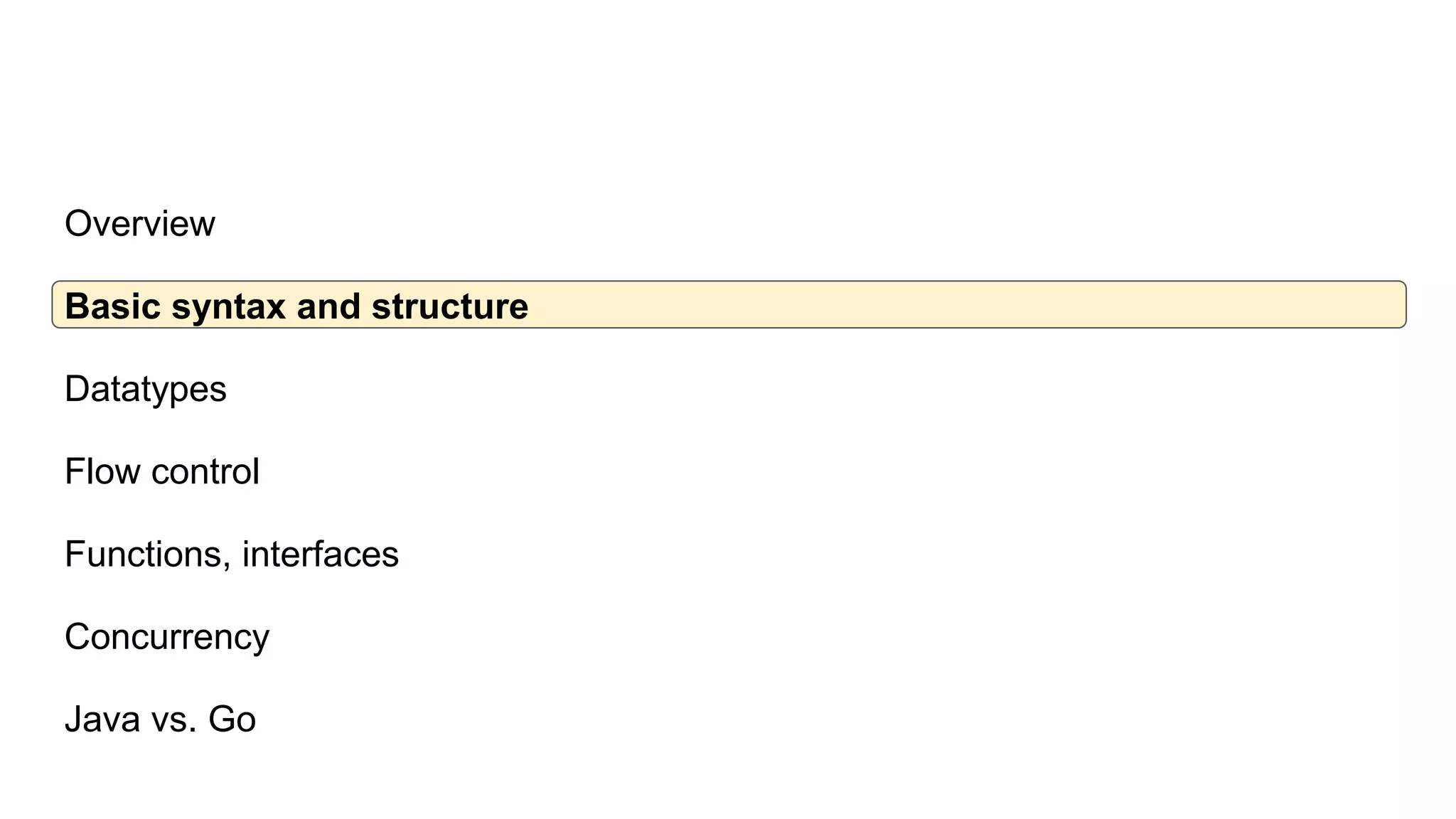
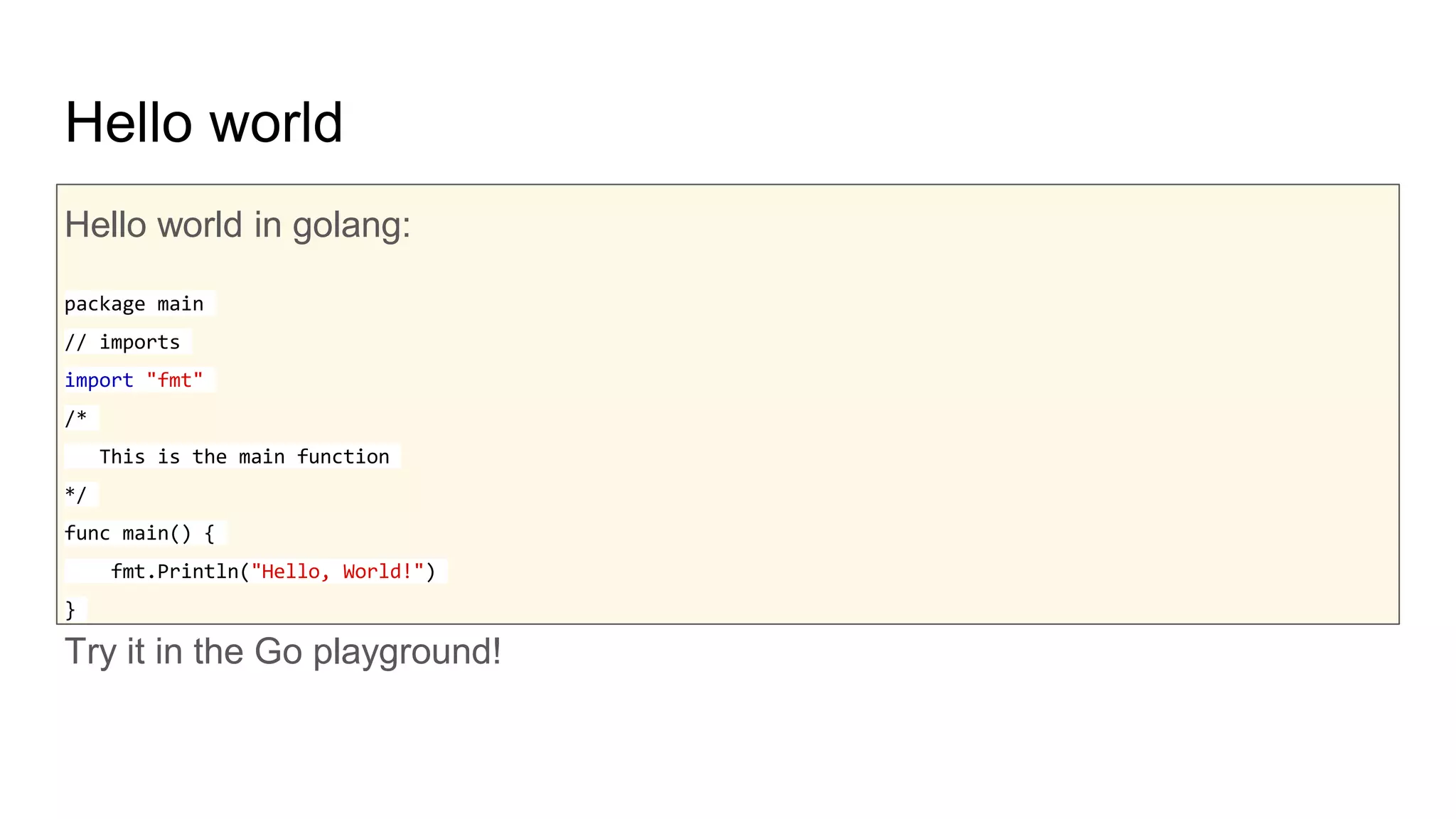
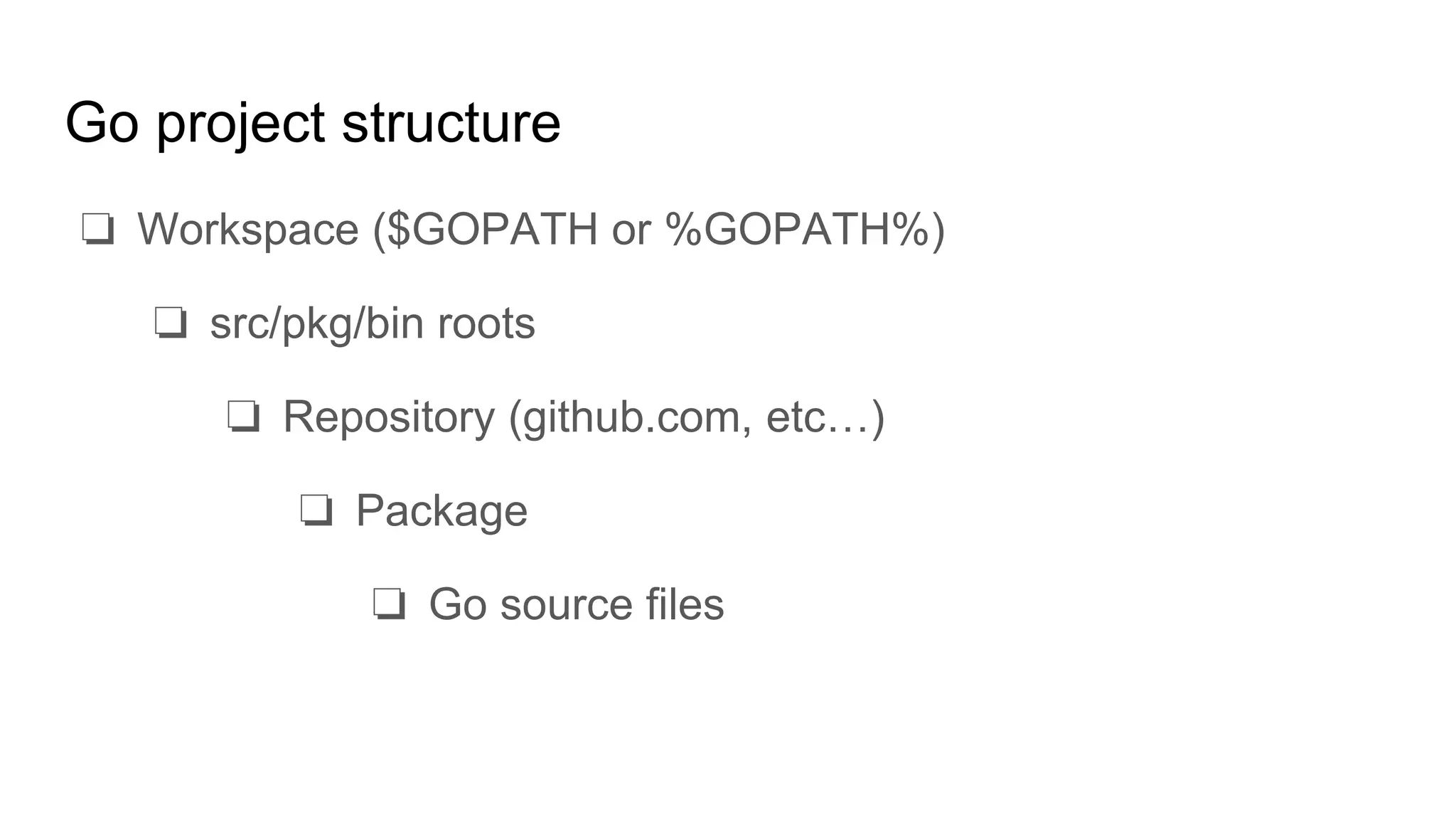
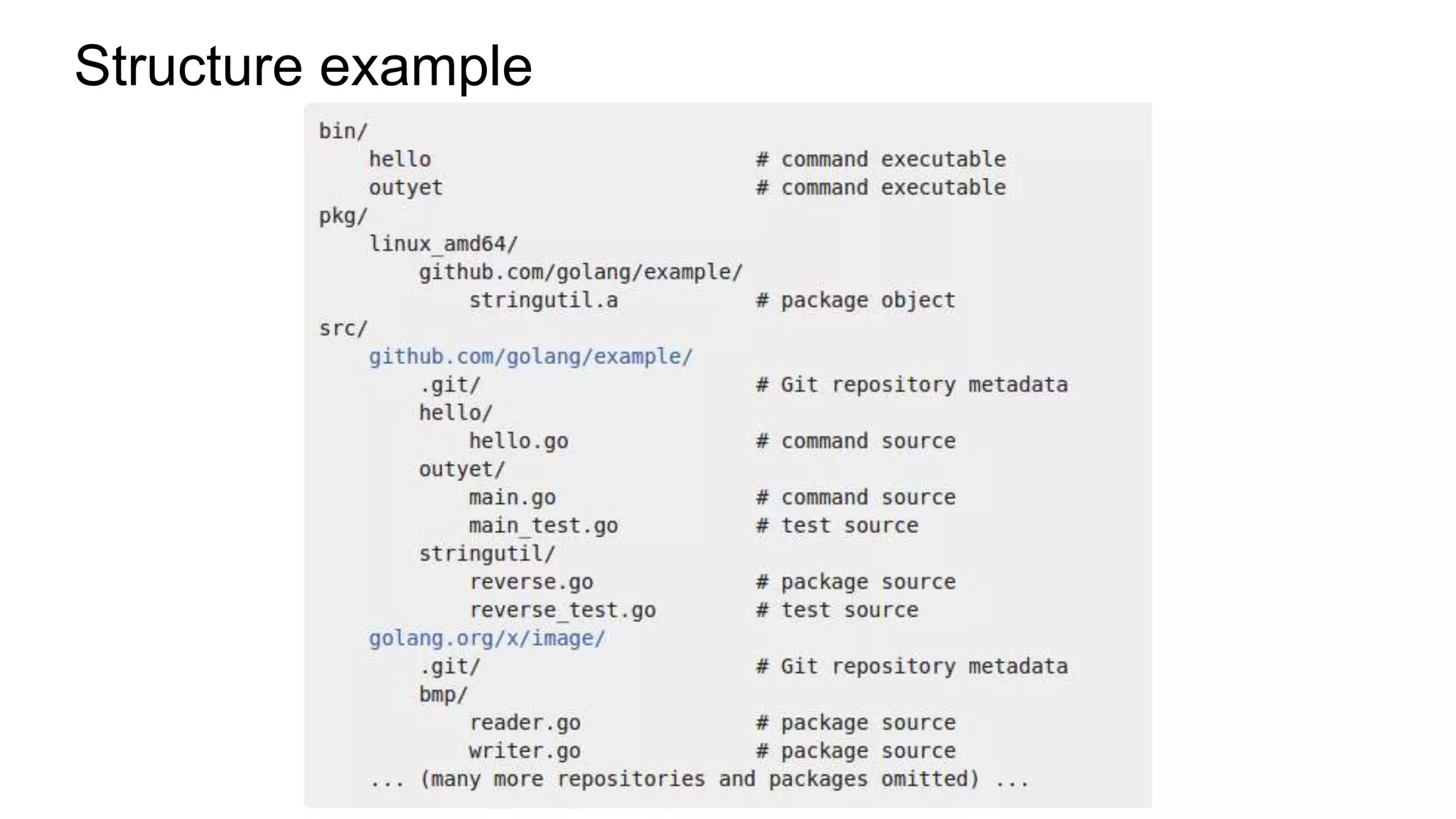
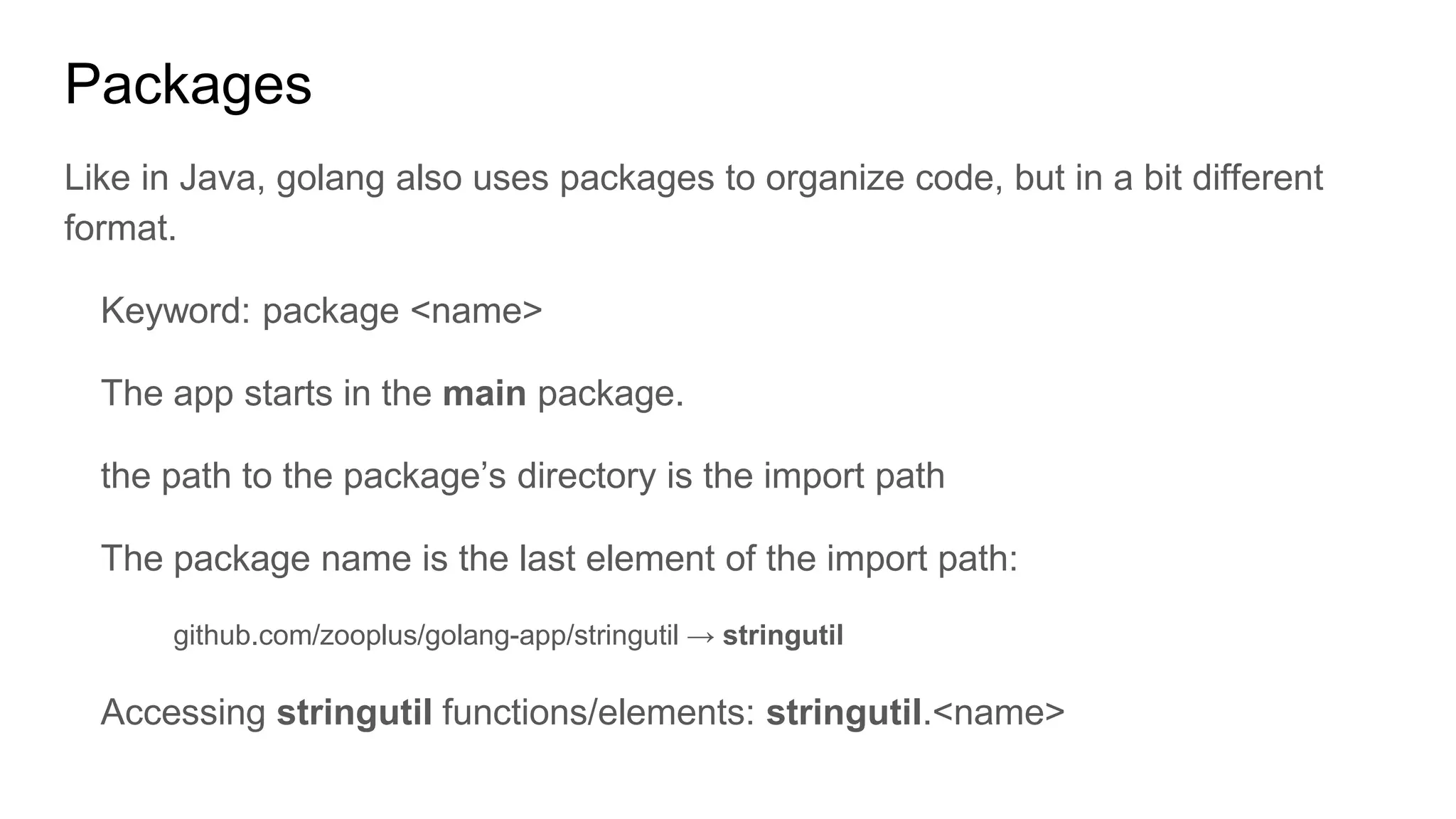
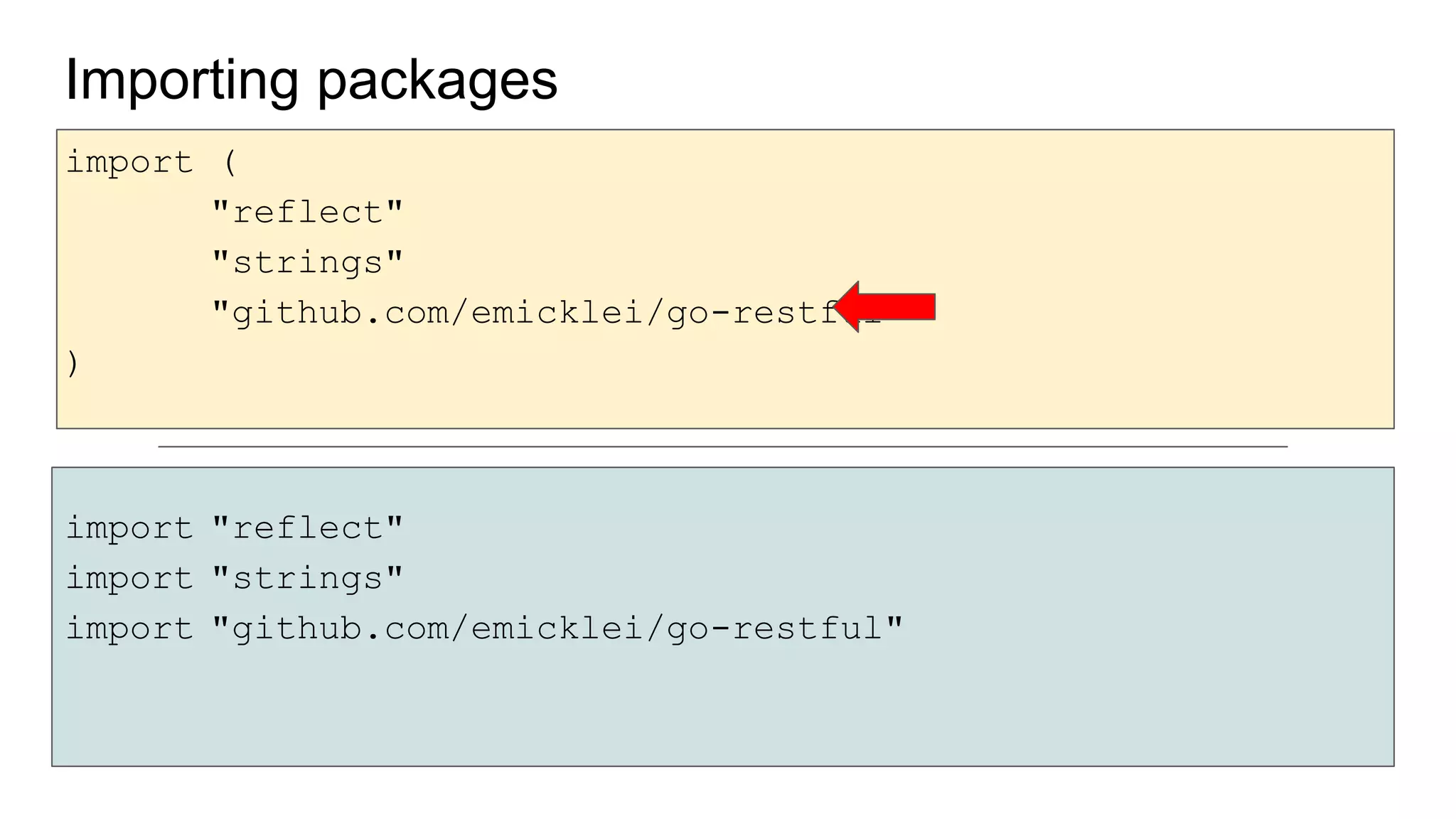
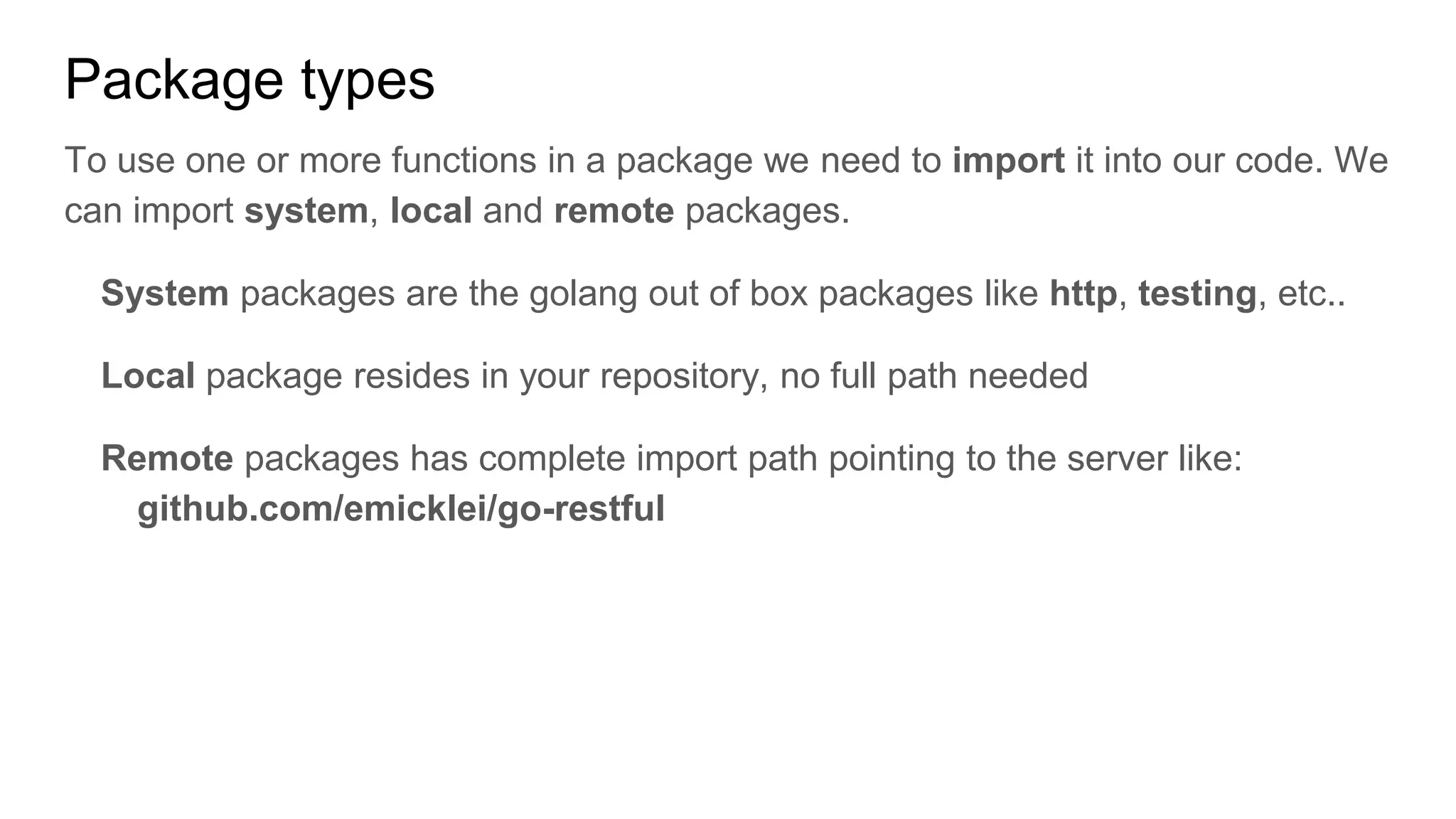
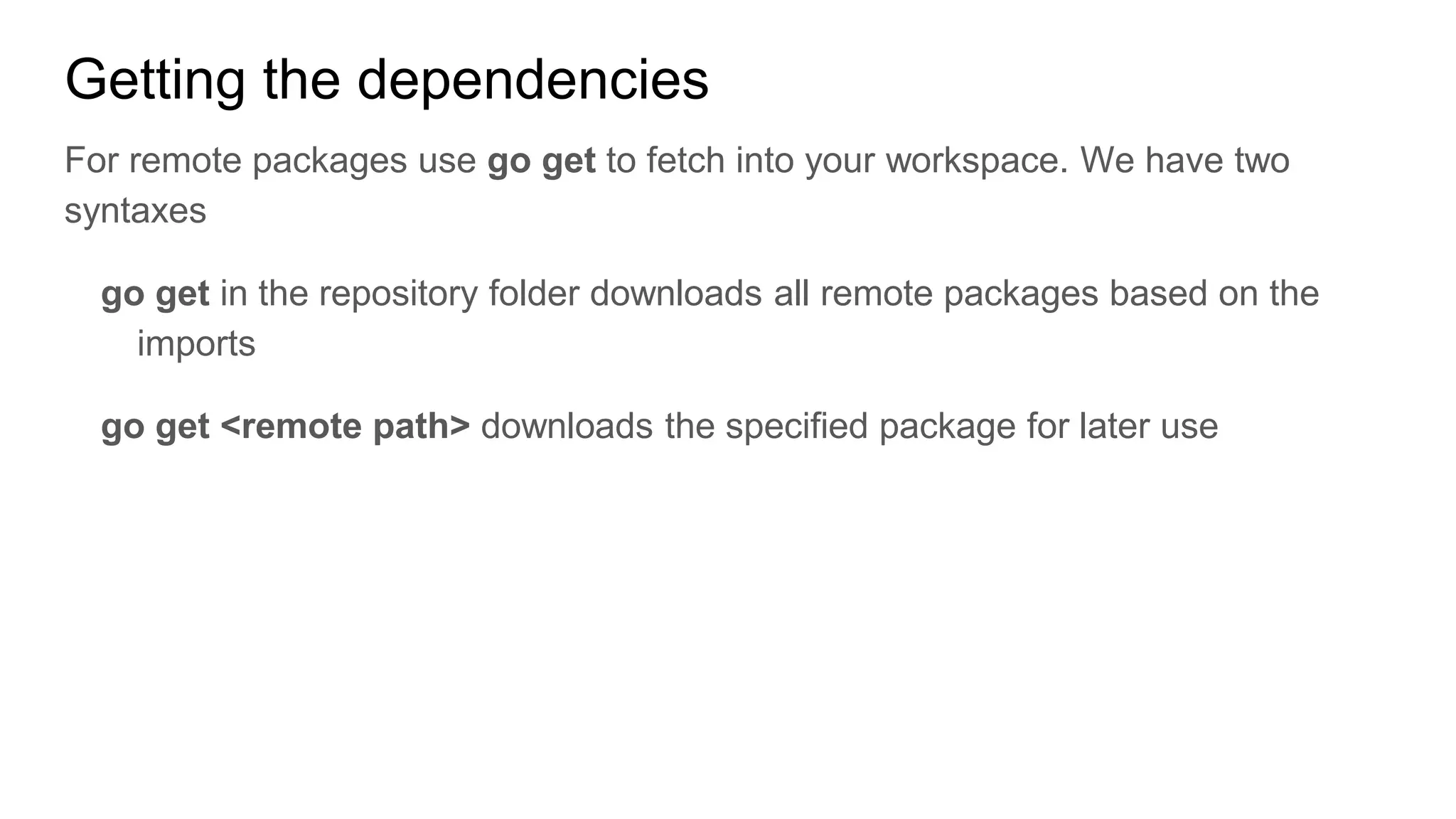
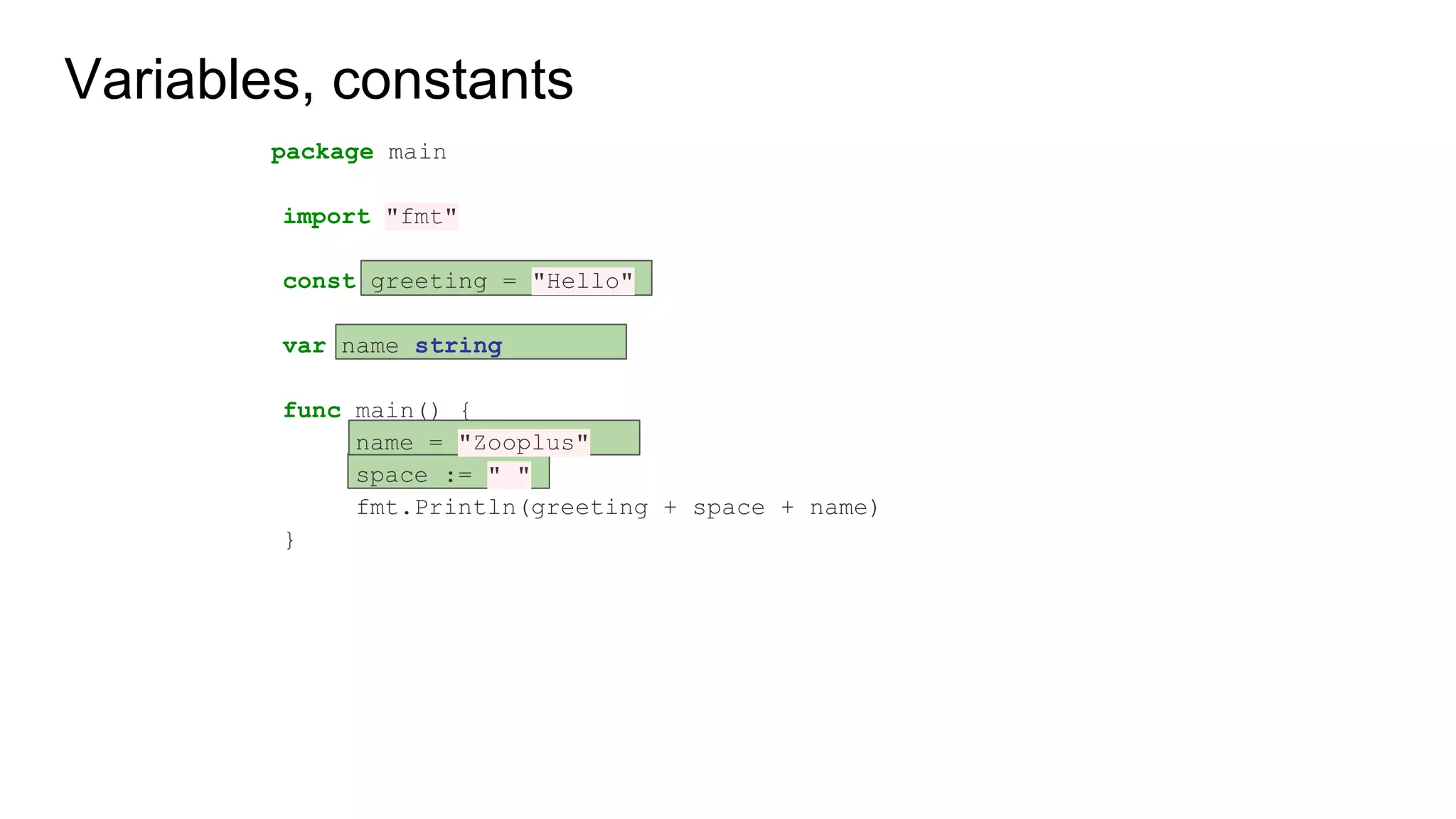
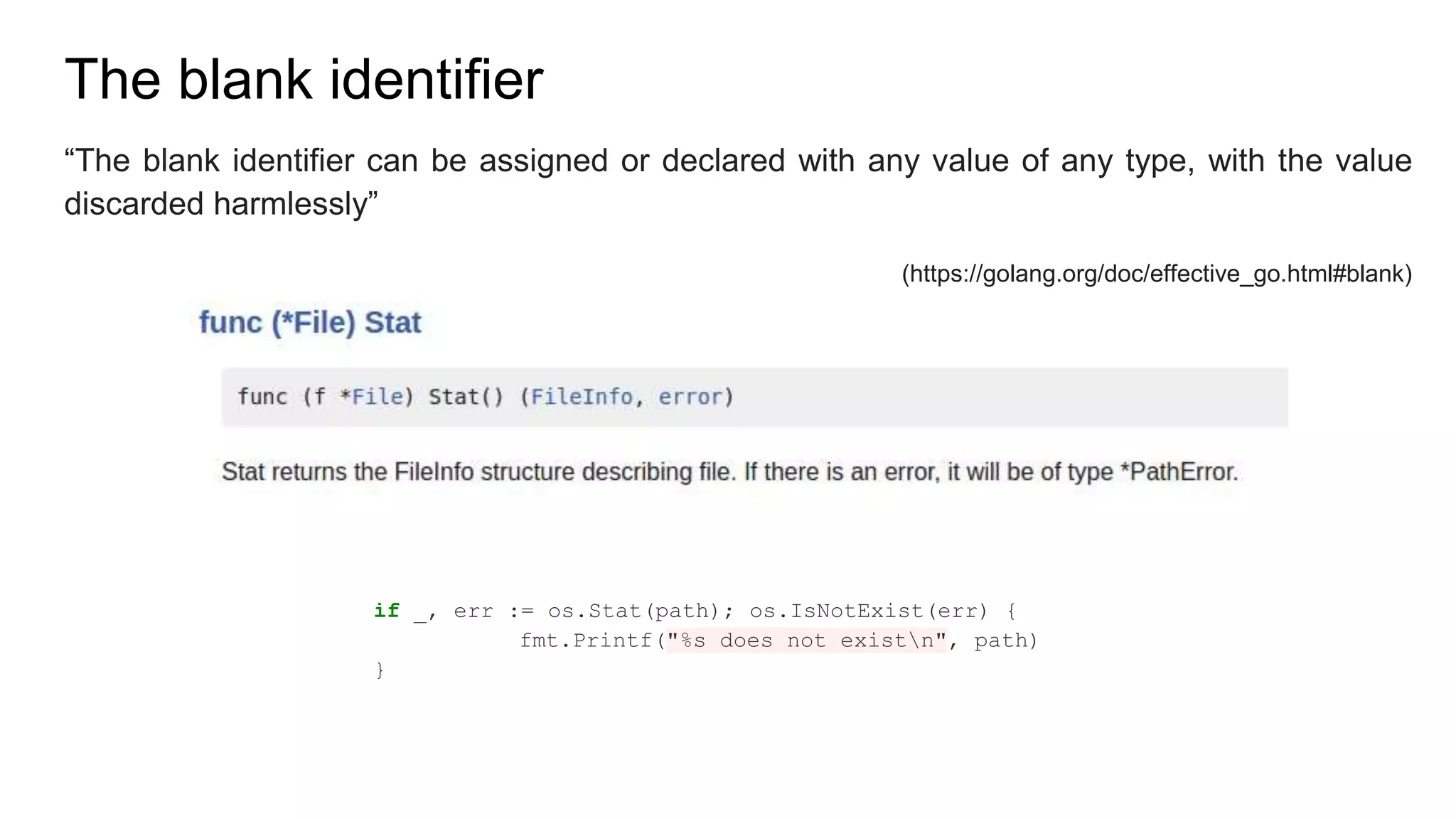
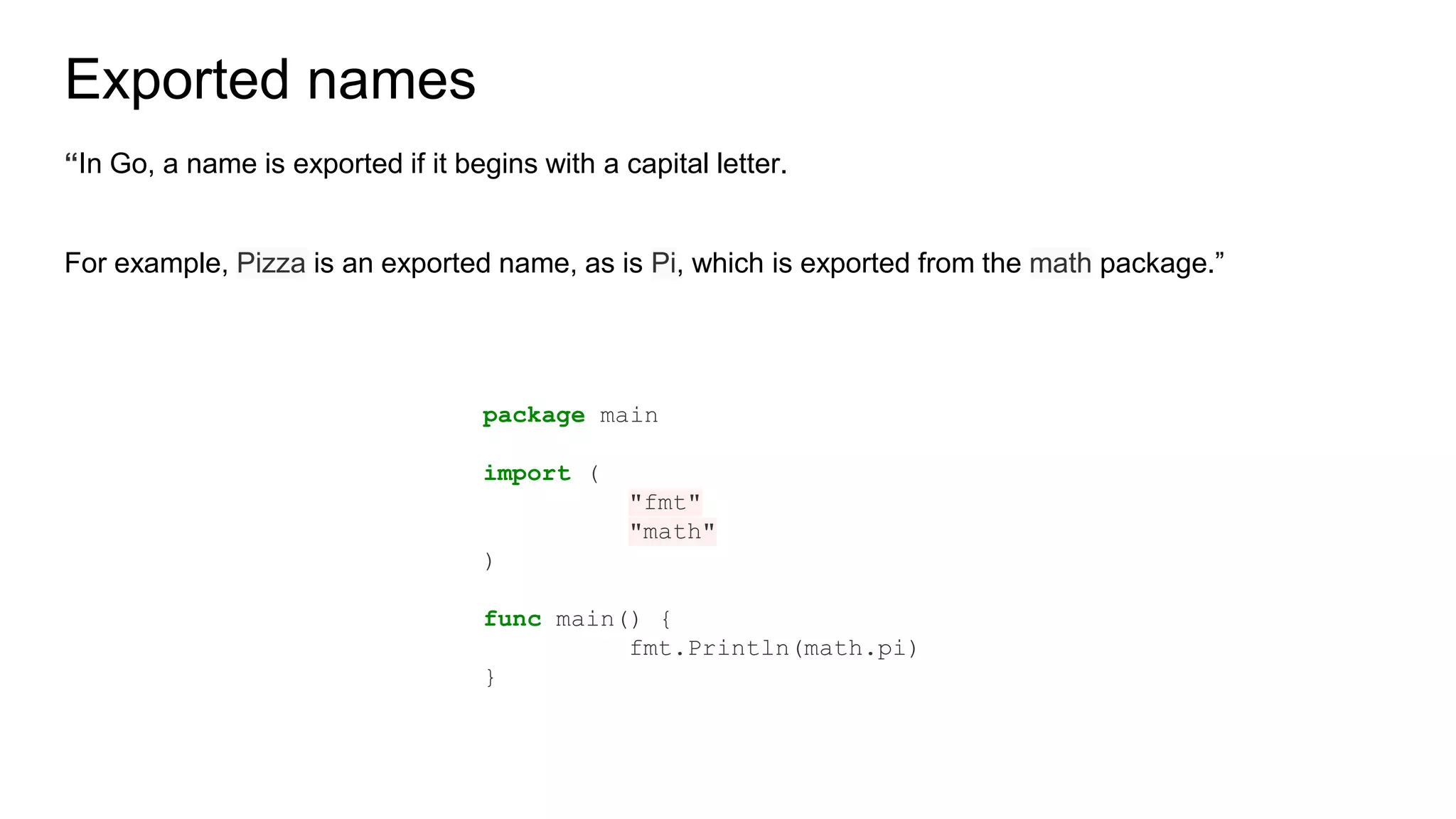
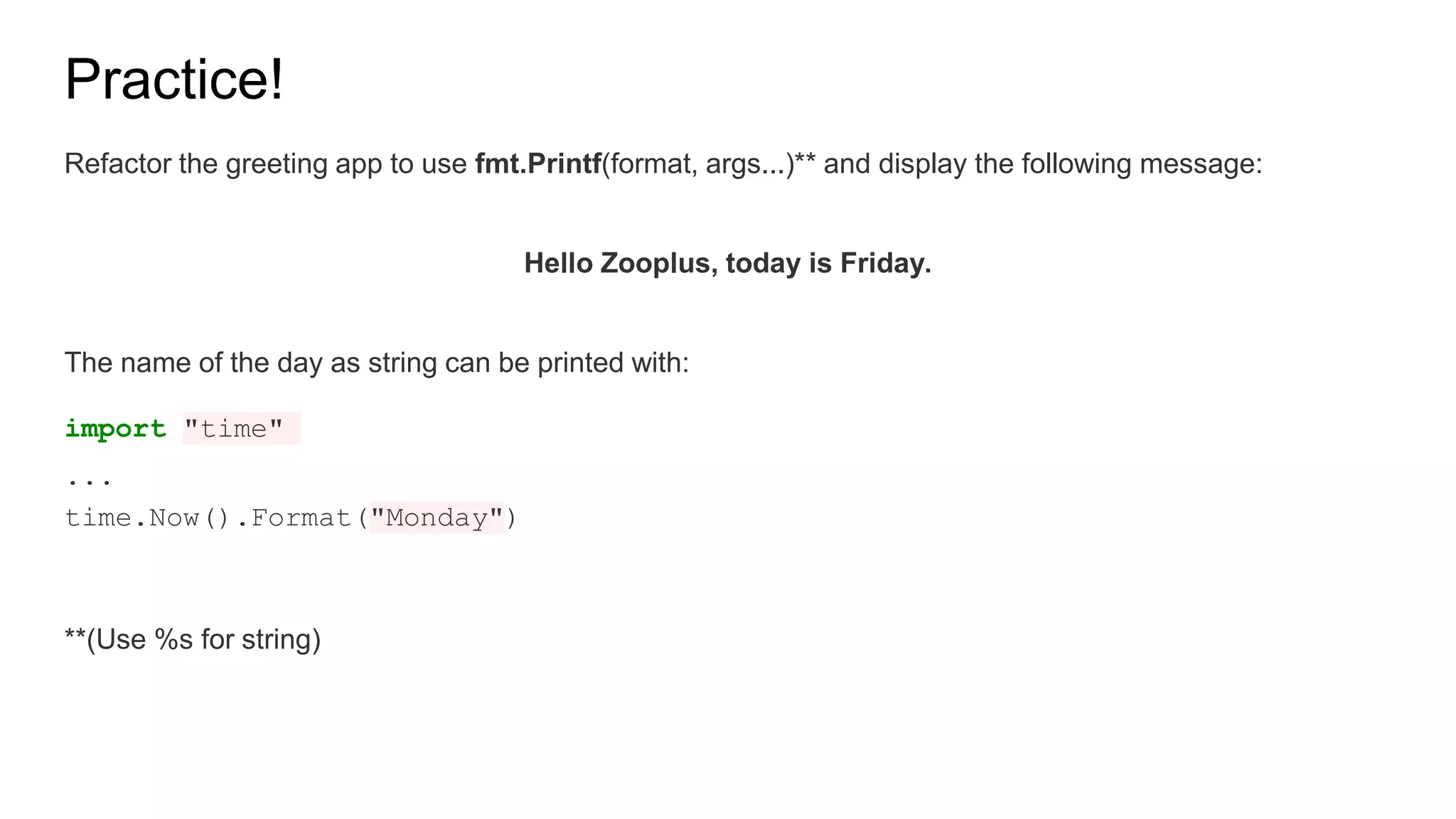
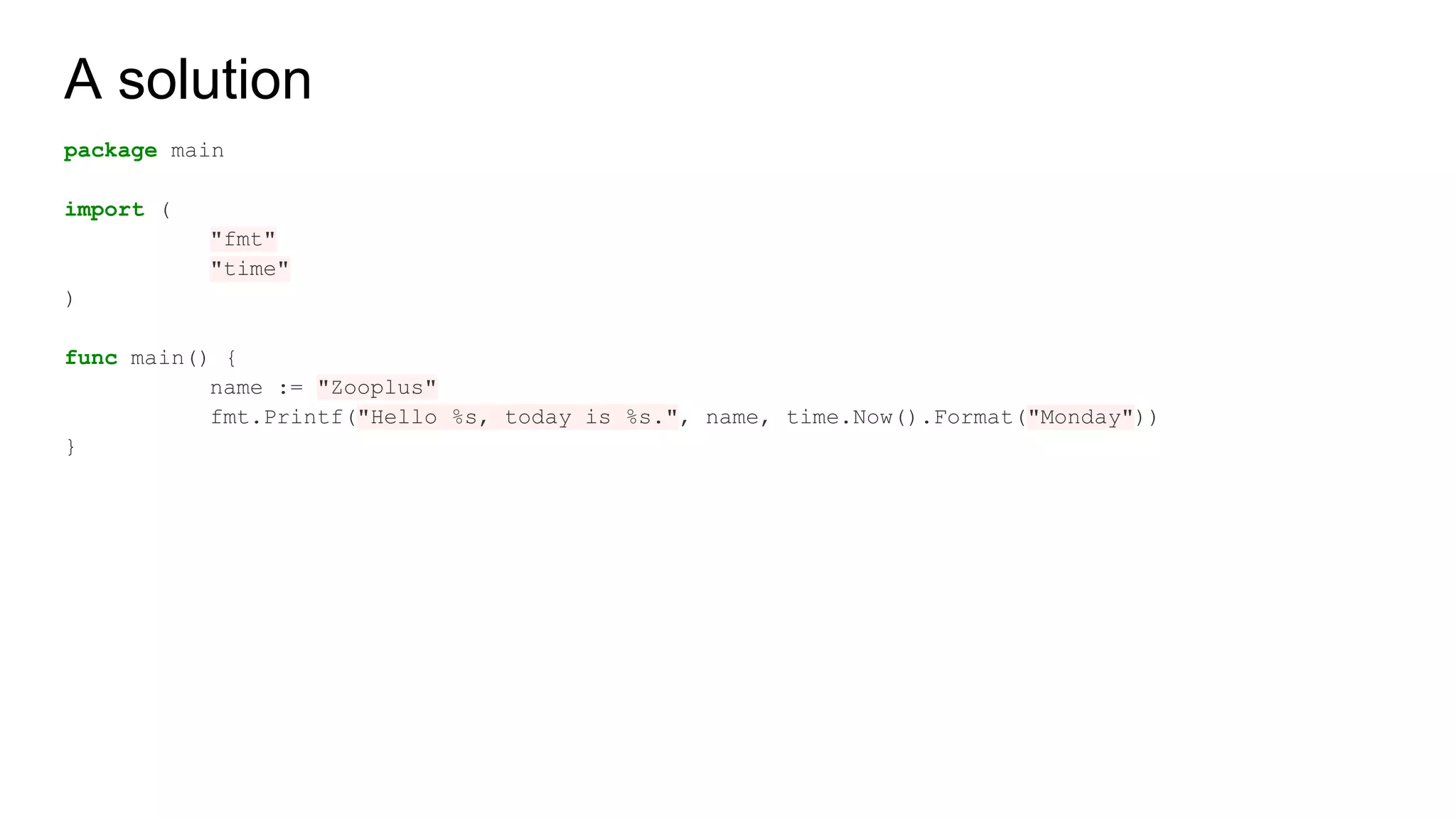
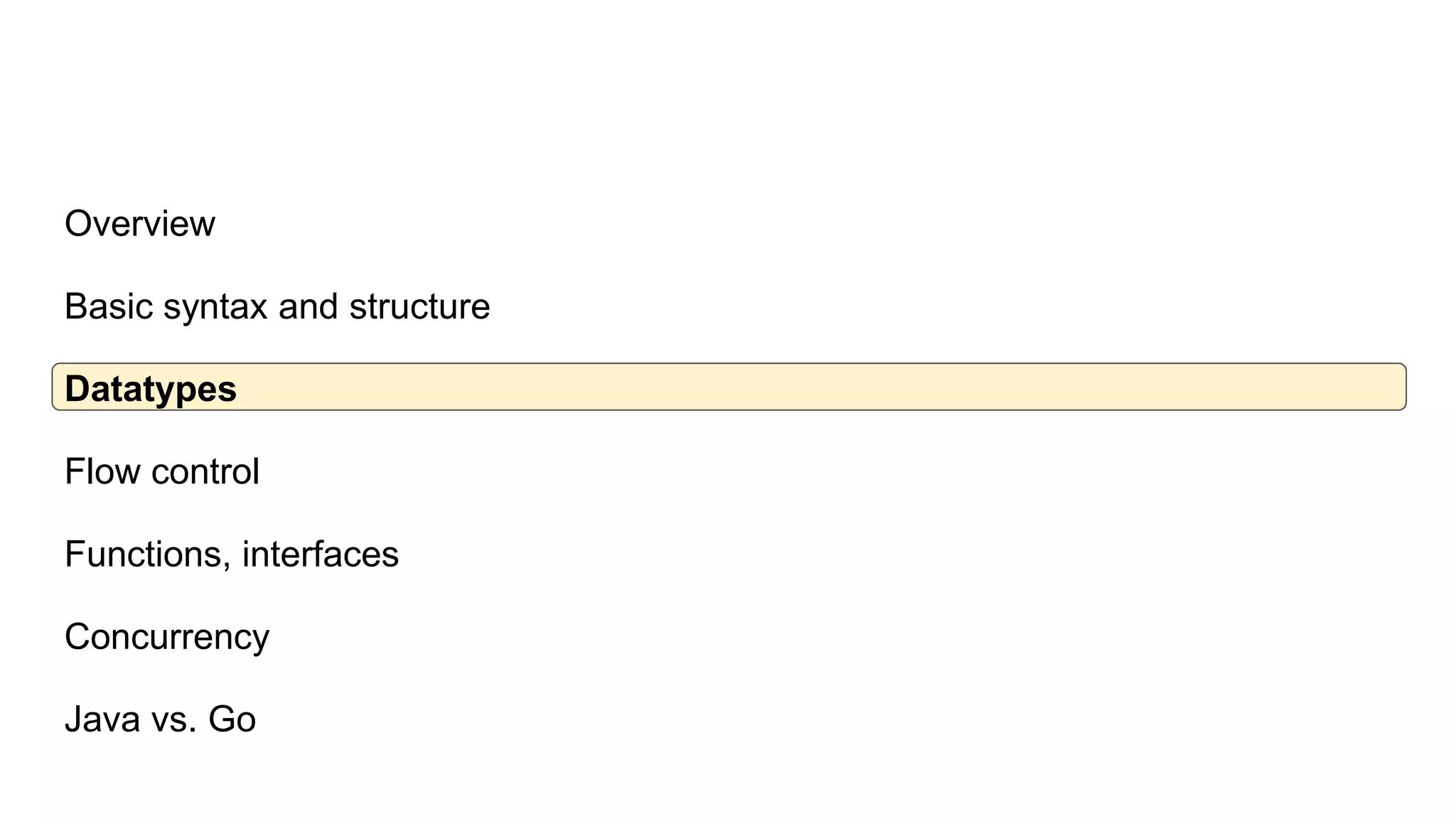
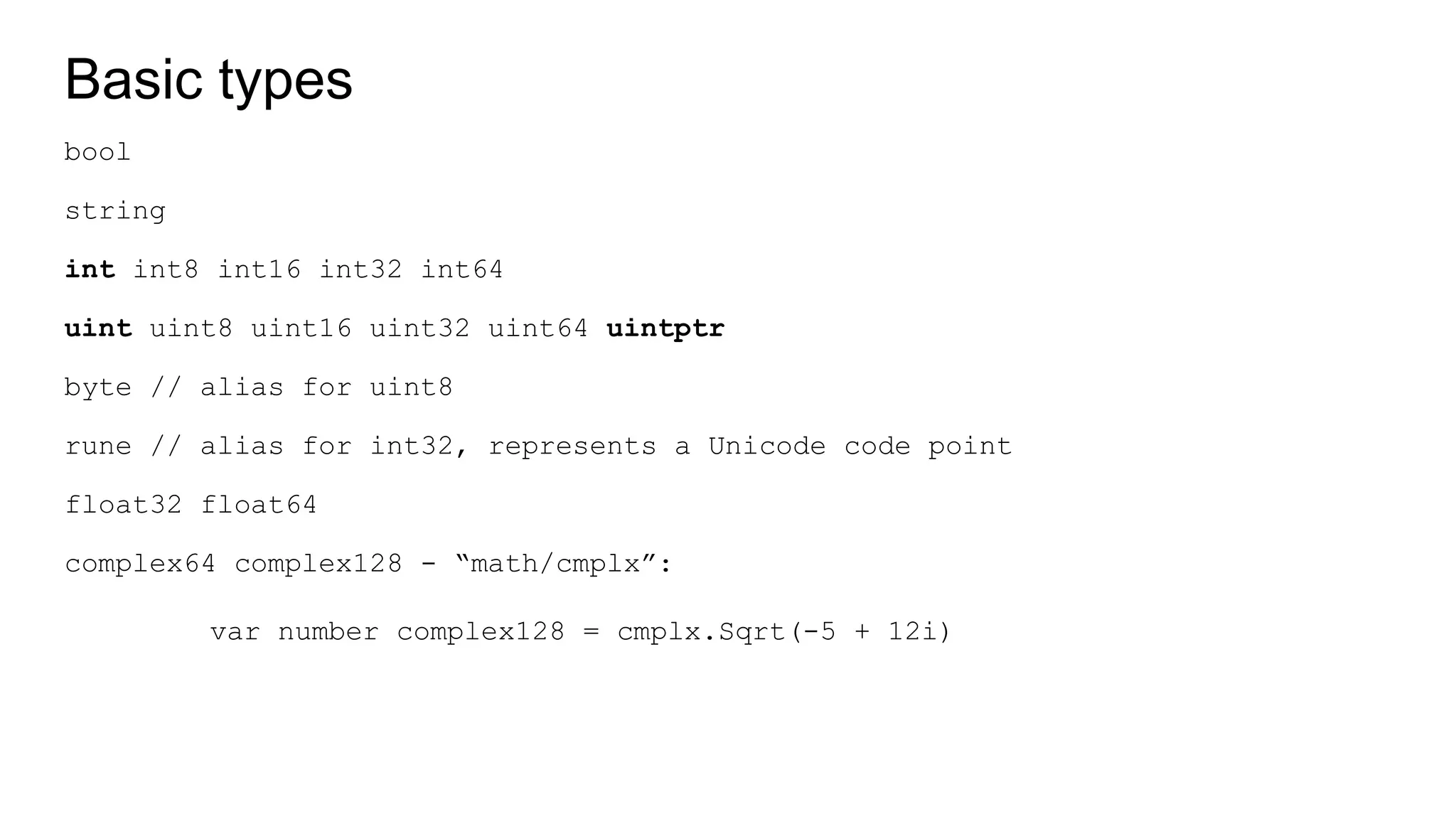
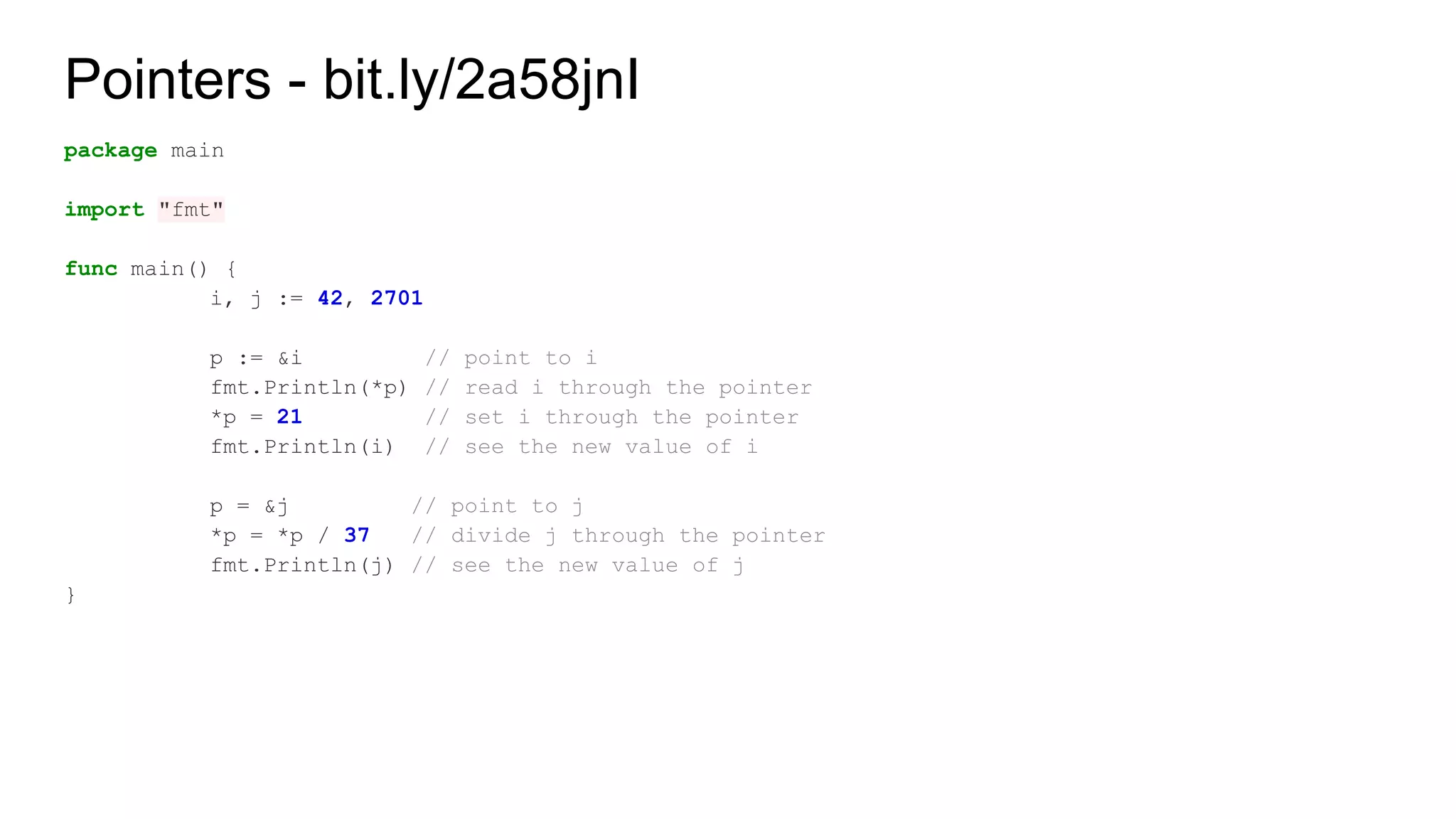
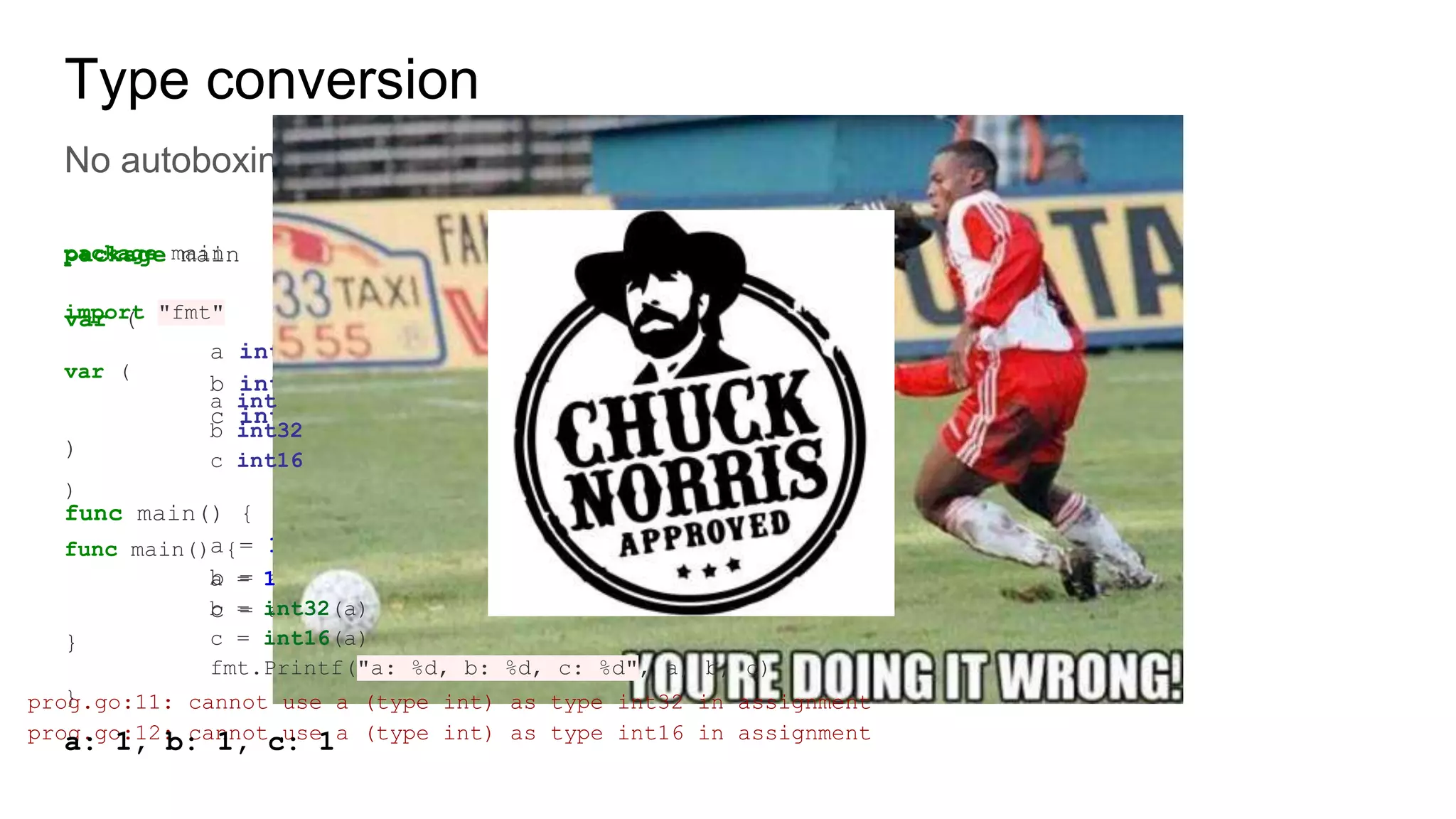
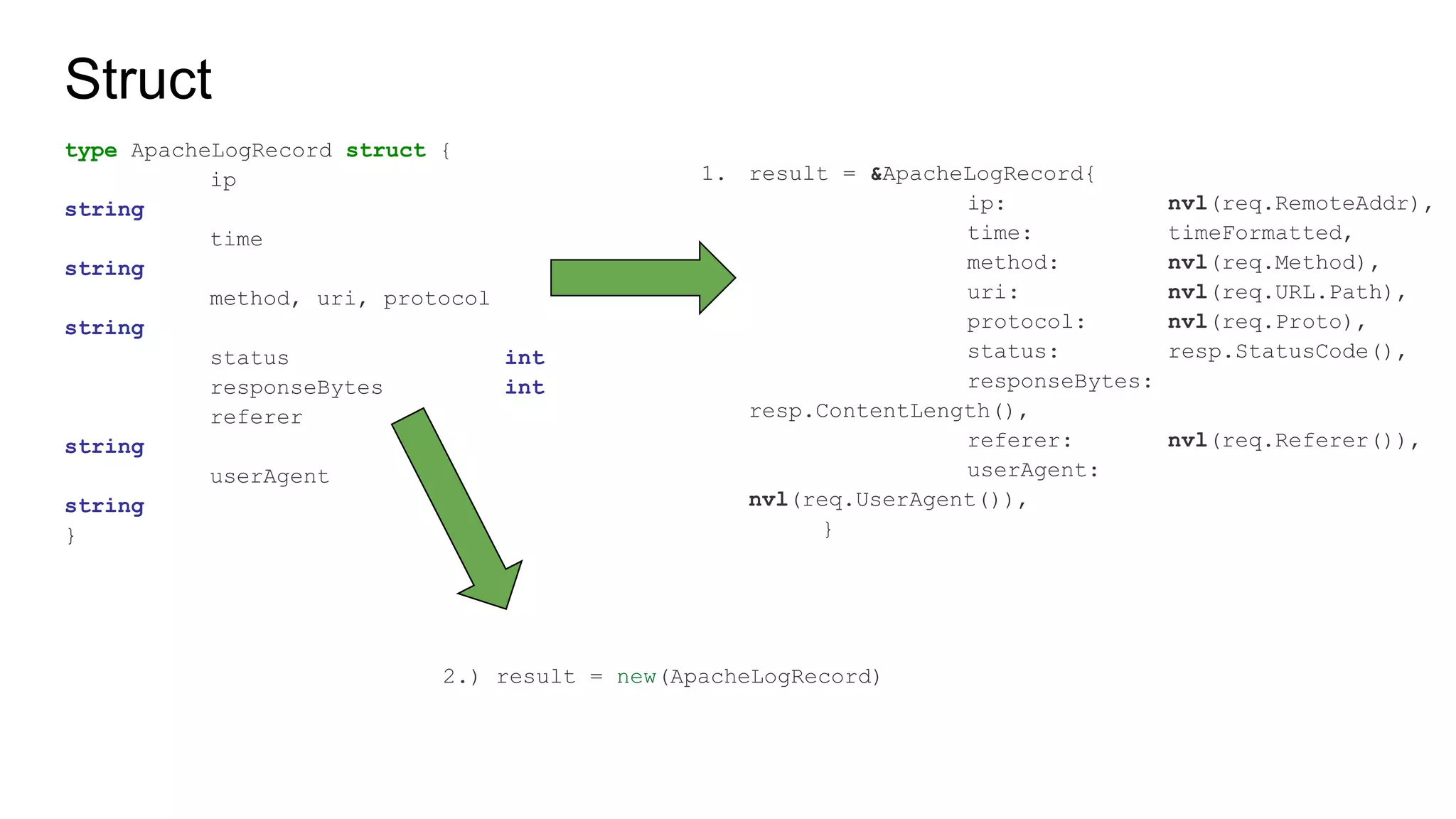
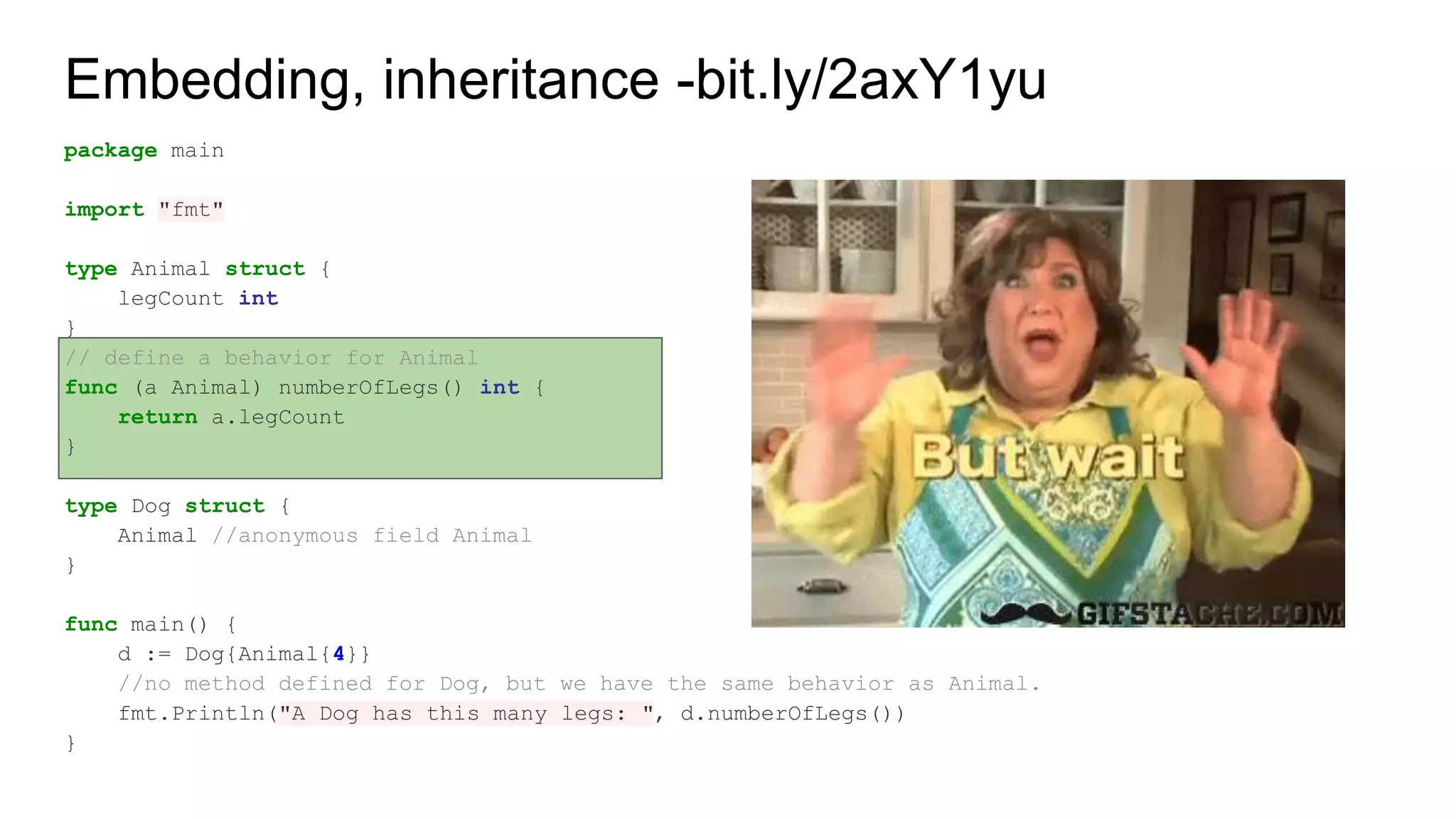
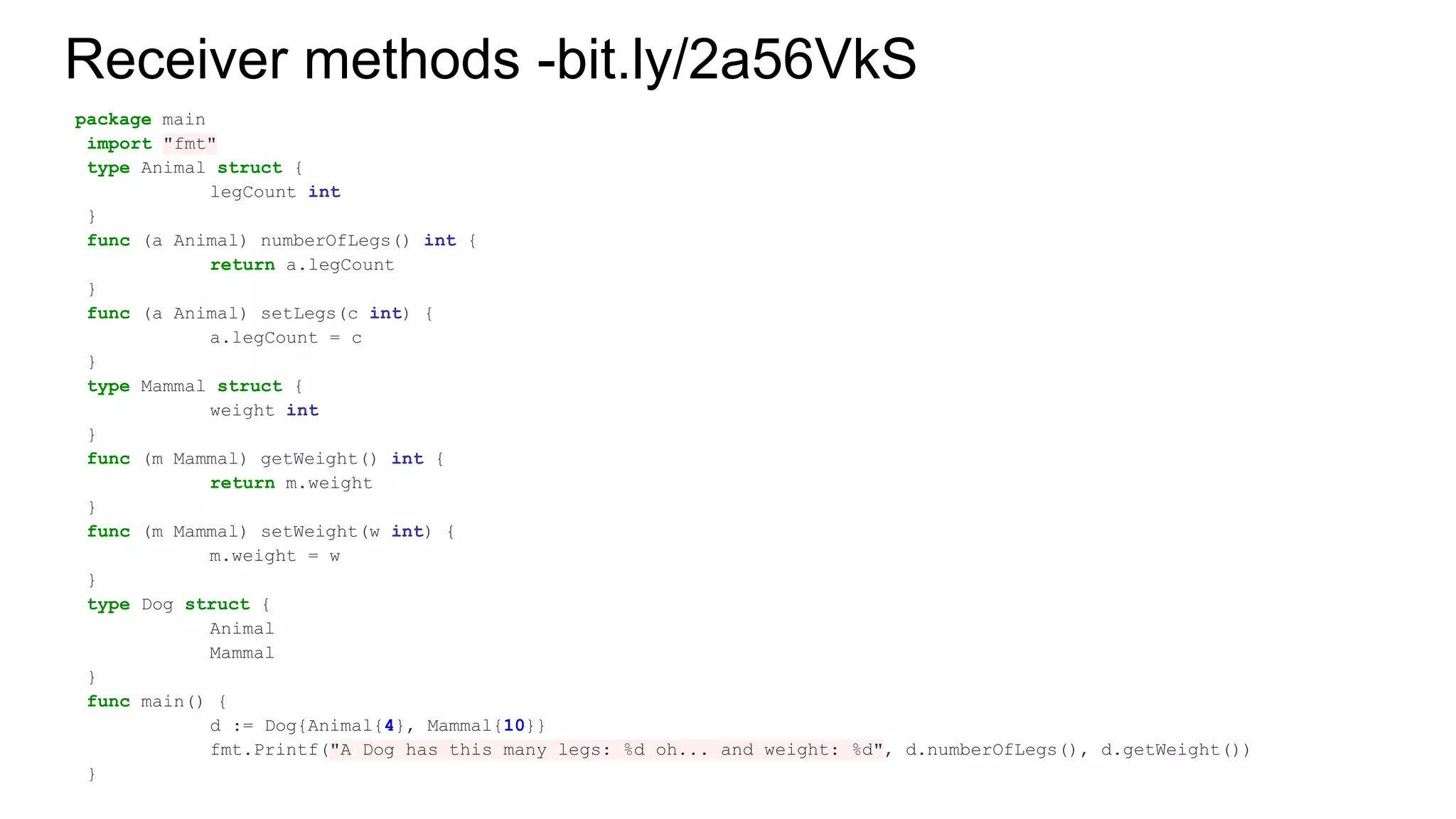
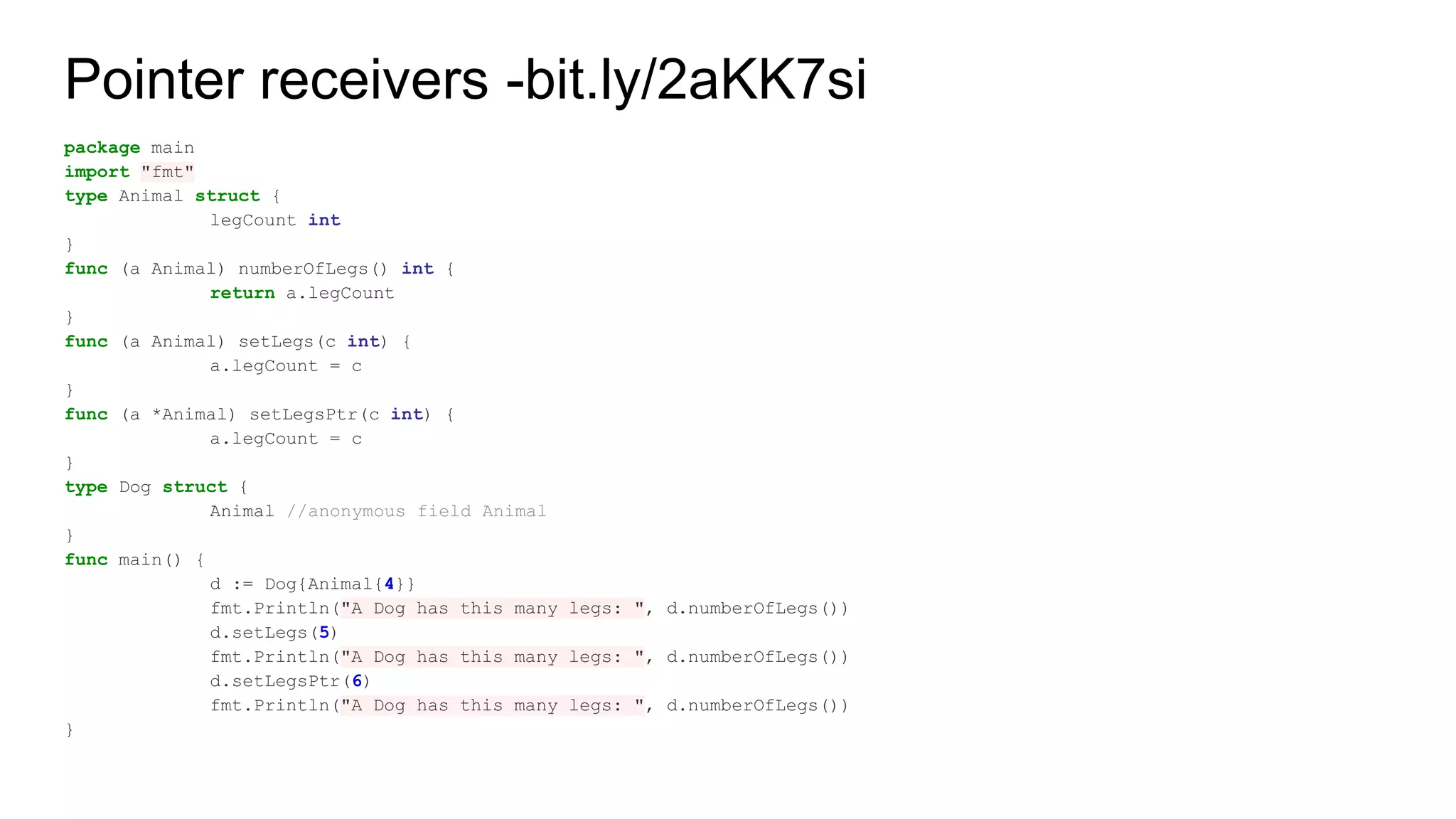
![Arrays -bit.ly/2ahx5EA
Arrays has fix size and type with zero based indexing:
var integers [20]int
package main
import "fmt"
func main() {
var a [2]string // std declaration
a[0] = "Hello"
a[1] = "Zooplus"
fmt.Println(a[0], a[1])
fmt.Println(a)
fibonacci := [6]int{1, 1, 2, 3, 5, 7} // on-the-fly declaration
fmt.Println(fibonacci)
}](https://image.slidesharecdn.com/tmcgafnsqhqjc2mdbt5r-signature-31951f50746f53d3c0233ba03f47eb612fb8fe3ac112be702f5d1c13630054c1-poli-160808202001/75/Golang-basics-for-Java-developers-Part-1-32-2048.jpg)
![Slices - bit.ly/2ahVarP
Slice is a dynamic version of array (a sort of):
var integers []int // decleration of a slice without size
package main
import "fmt"
func main() {
fibonacci := [6]int{1, 1, 2, 3, 5, 7}
var p []int = fibonacci[1:4]
fmt.Println(p)
}](https://image.slidesharecdn.com/tmcgafnsqhqjc2mdbt5r-signature-31951f50746f53d3c0233ba03f47eb612fb8fe3ac112be702f5d1c13630054c1-poli-160808202001/75/Golang-basics-for-Java-developers-Part-1-33-2048.jpg)
![Slices are not storing data - bit.ly/2aai1Wx
package main
import "fmt"
func main() {
names := [4]string{
"John",
"Paul",
"George",
"Ringo",
}
fmt.Println(names)
a := names[0:2]
b := names[1:3]
fmt.Println(a, b)
b[0] = "XXX"
fmt.Println(a, b)
fmt.Println(names)
}](https://image.slidesharecdn.com/tmcgafnsqhqjc2mdbt5r-signature-31951f50746f53d3c0233ba03f47eb612fb8fe3ac112be702f5d1c13630054c1-poli-160808202001/75/Golang-basics-for-Java-developers-Part-1-34-2048.jpg)
![Slices - bounds
There are default low and high bounds for slices. Given the following array:
var a [10]int
The following slice declarations are equivalent:
a[0:10]
a[:10]
a[0:]
a[:]](https://image.slidesharecdn.com/tmcgafnsqhqjc2mdbt5r-signature-31951f50746f53d3c0233ba03f47eb612fb8fe3ac112be702f5d1c13630054c1-poli-160808202001/75/Golang-basics-for-Java-developers-Part-1-35-2048.jpg)
![Creating slice:
a := make([]int, 5) // len(a)=5
Creating slice with capacity:
b := make([]int, 0, 5) // len(b)=0, cap(b)=5
Appending slice:
b = append(b, 10)
Further reading: https://blog.golang.org/go-slices-usage-and-internals
Slices - create, append](https://image.slidesharecdn.com/tmcgafnsqhqjc2mdbt5r-signature-31951f50746f53d3c0233ba03f47eb612fb8fe3ac112be702f5d1c13630054c1-poli-160808202001/75/Golang-basics-for-Java-developers-Part-1-36-2048.jpg)
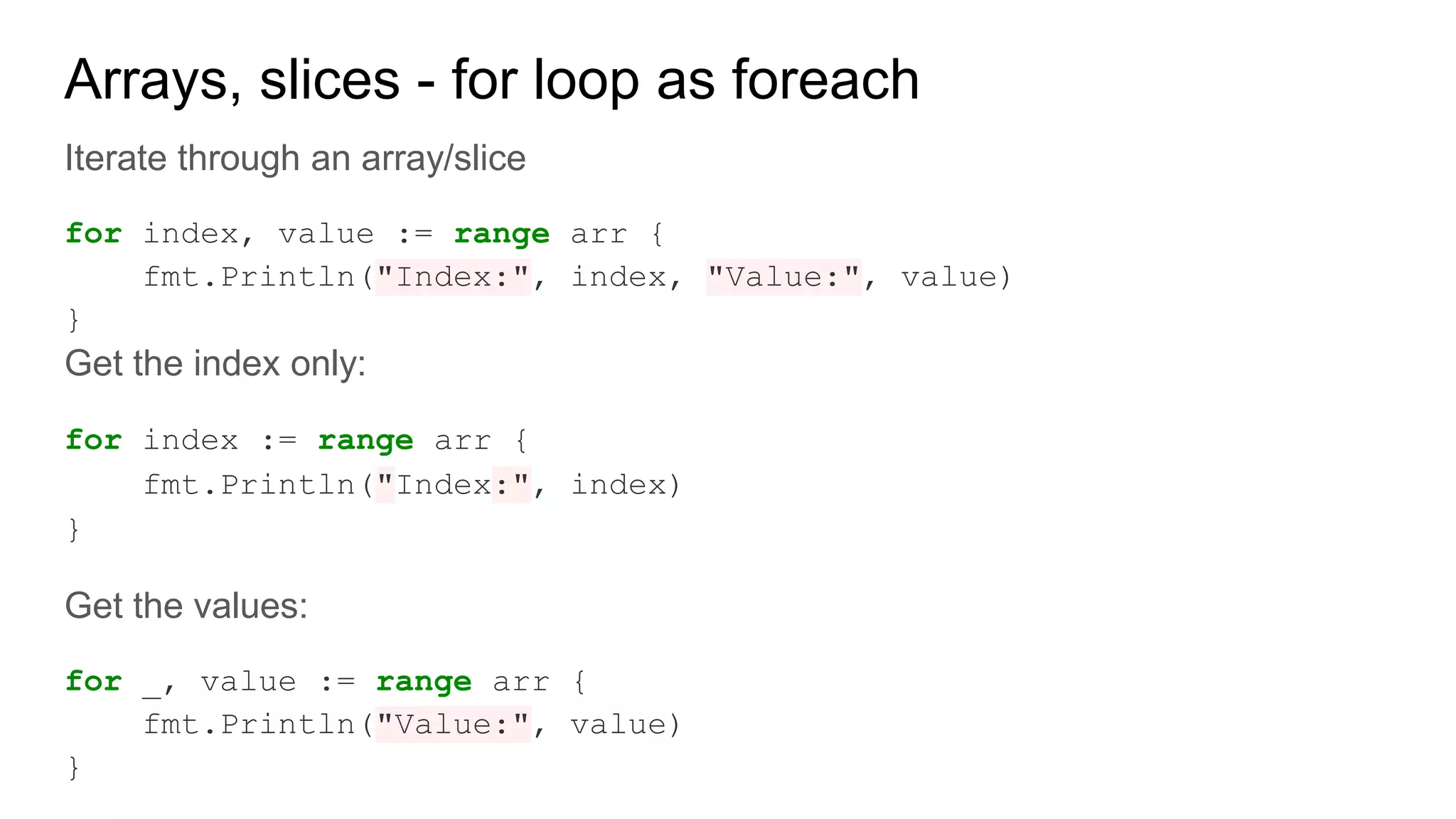
![Maps - declaration, initialization
Maps are not initialized by default, we should use make:
package main
import "fmt"
var m map[string]string
func main() {
m = make(map[string]string)
m["Zooplus"] = "Gut"
m["Bitiba"] = "Gut"
m["Fressnapf"] = "Falsch"
fmt.Println(m["Zooplus"])
}](https://image.slidesharecdn.com/tmcgafnsqhqjc2mdbt5r-signature-31951f50746f53d3c0233ba03f47eb612fb8fe3ac112be702f5d1c13630054c1-poli-160808202001/75/Golang-basics-for-Java-developers-Part-1-38-2048.jpg)
![Maps - Mutating maps
m[key] = item // upsert
item = m[key] // retrieve
delete (m, key) // guess….
_, ok = m[key] // ok == true if key exists, map can store/return nil
Maps are not thread safe!!!](https://image.slidesharecdn.com/tmcgafnsqhqjc2mdbt5r-signature-31951f50746f53d3c0233ba03f47eb612fb8fe3ac112be702f5d1c13630054c1-poli-160808202001/75/Golang-basics-for-Java-developers-Part-1-39-2048.jpg)
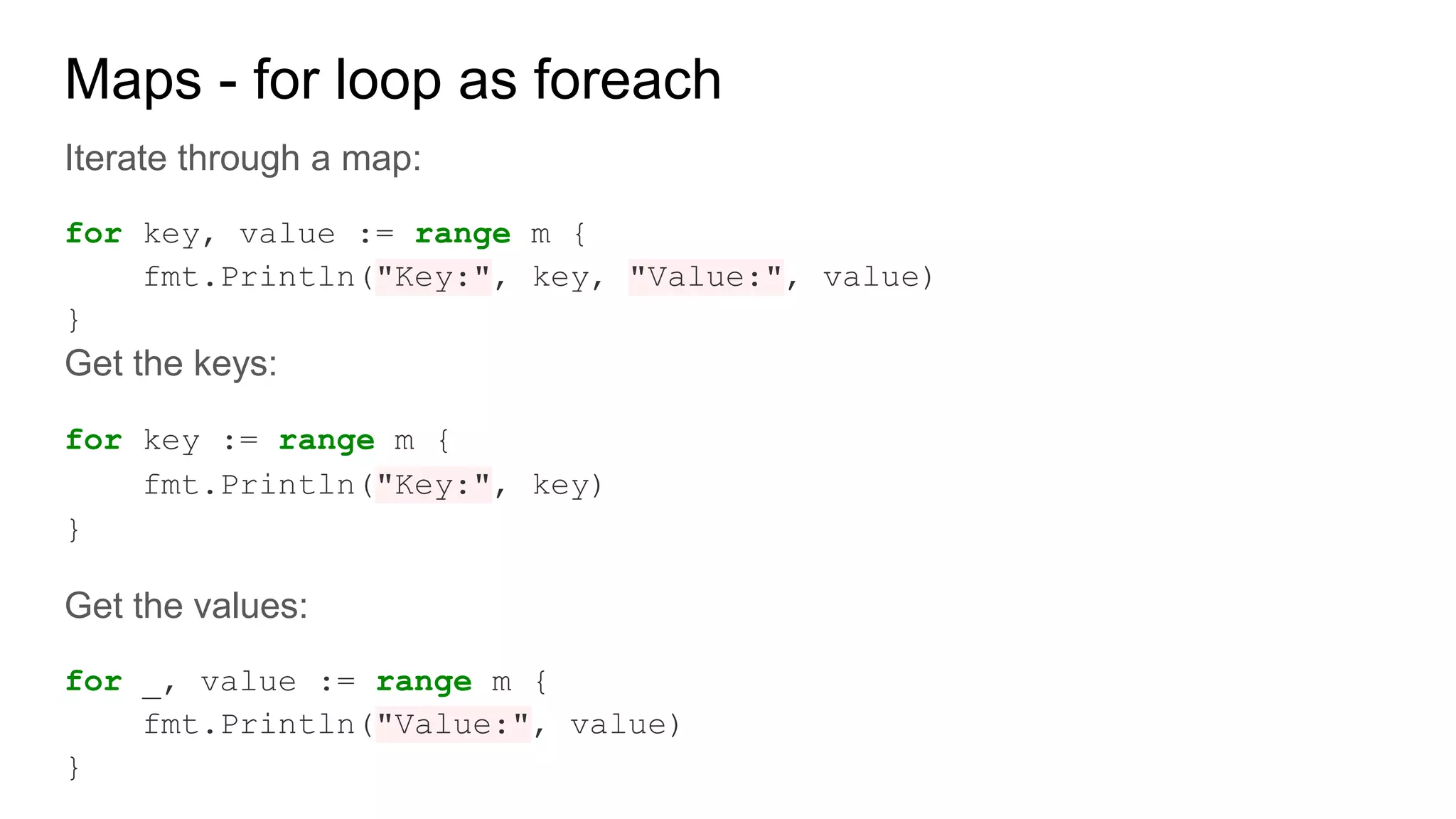
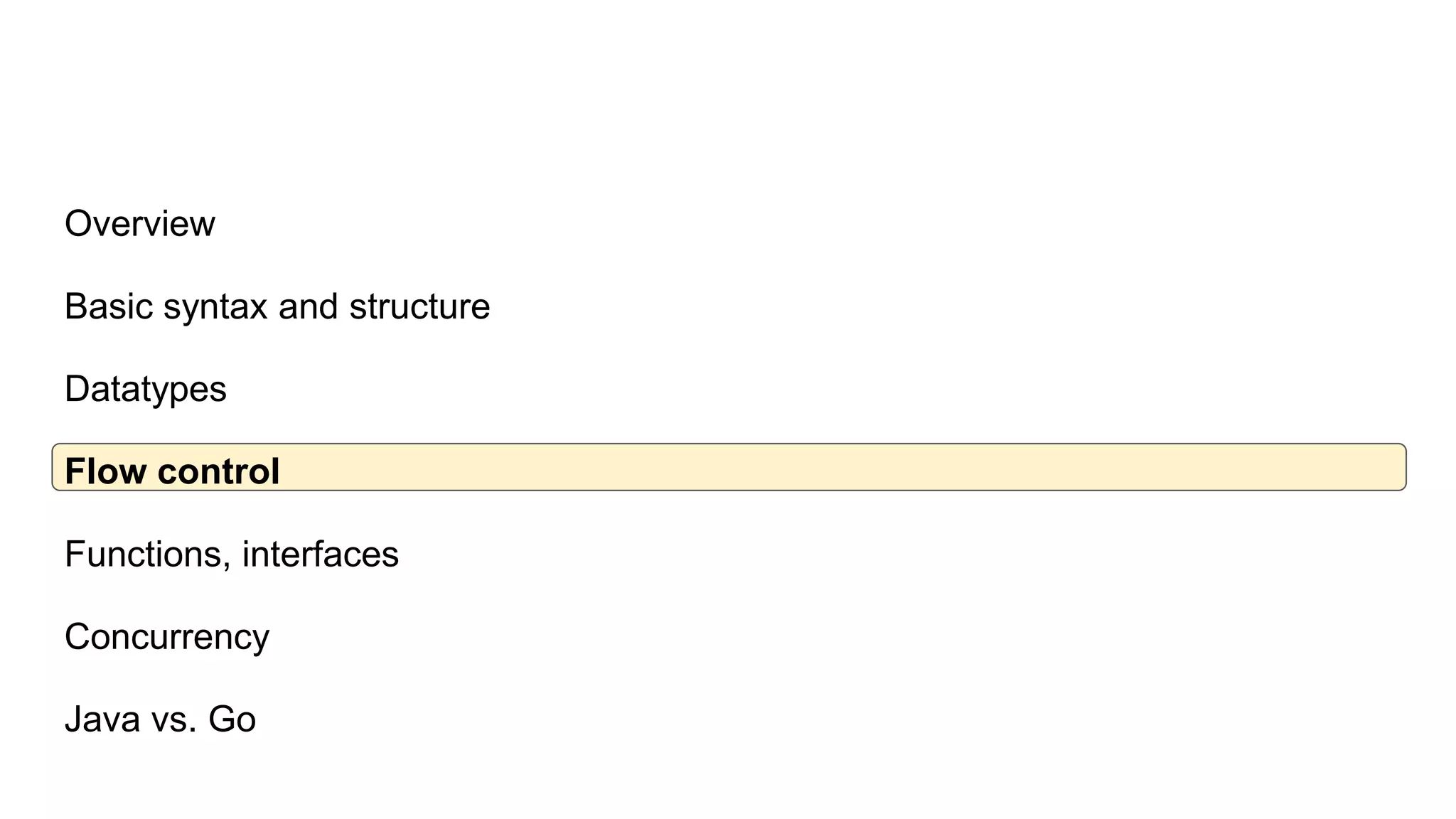
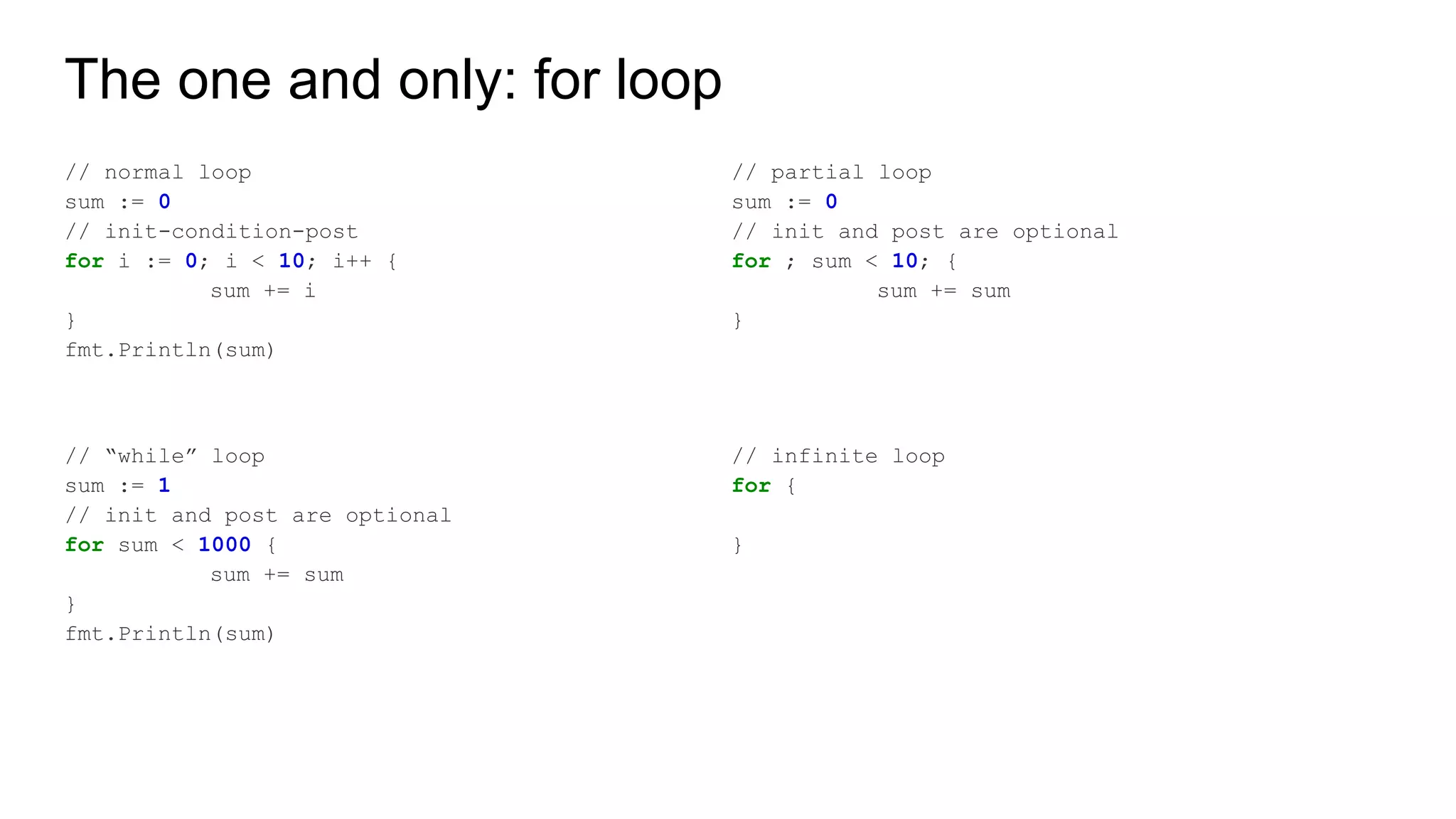
![func GetProject(req *restful.Request, resp *restful.Response) {
resp.Header().Set("Pragma", "no-cache")
//
pId := req.PathParameter("projectId")
if project, ok := projects.GetProjectByIdOrName(pId); ok
{
ReturnJSON(resp, http.StatusOK, project)
}
ReturnMessage(resp, http.StatusNotFound, "Project not
found!")
}
If-then-else
existingPipeline, ok := nameSpace.Pipelines[newPipeline.Name]
if ok {
log.Debug("Entry exists!")
} else {
nameSpace.Pipelines[newPipeline.Name] = existingPipeline
log.Debug("New entry stored")
}
?](https://image.slidesharecdn.com/tmcgafnsqhqjc2mdbt5r-signature-31951f50746f53d3c0233ba03f47eb612fb8fe3ac112be702f5d1c13630054c1-poli-160808202001/75/Golang-basics-for-Java-developers-Part-1-43-2048.jpg)
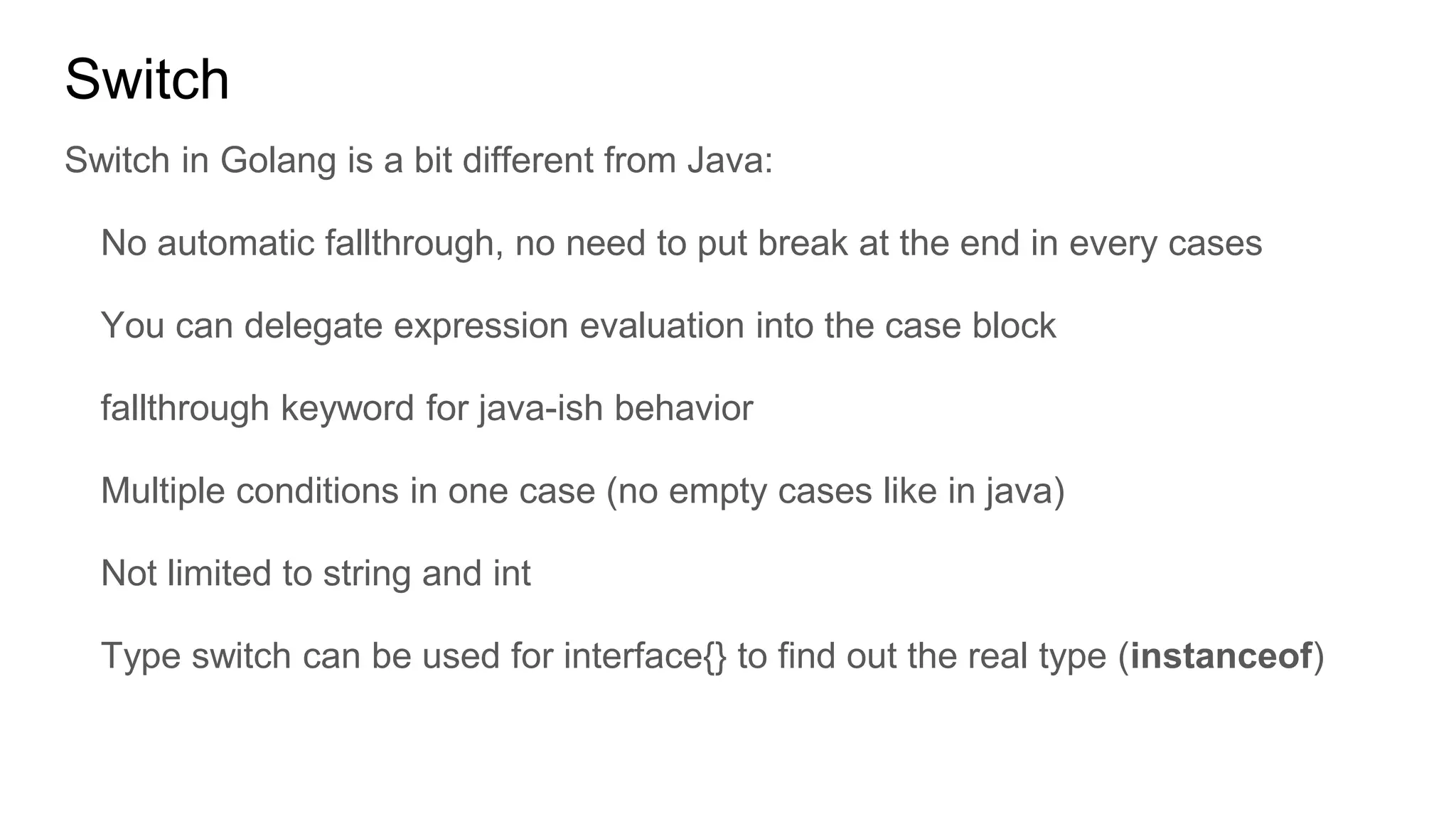
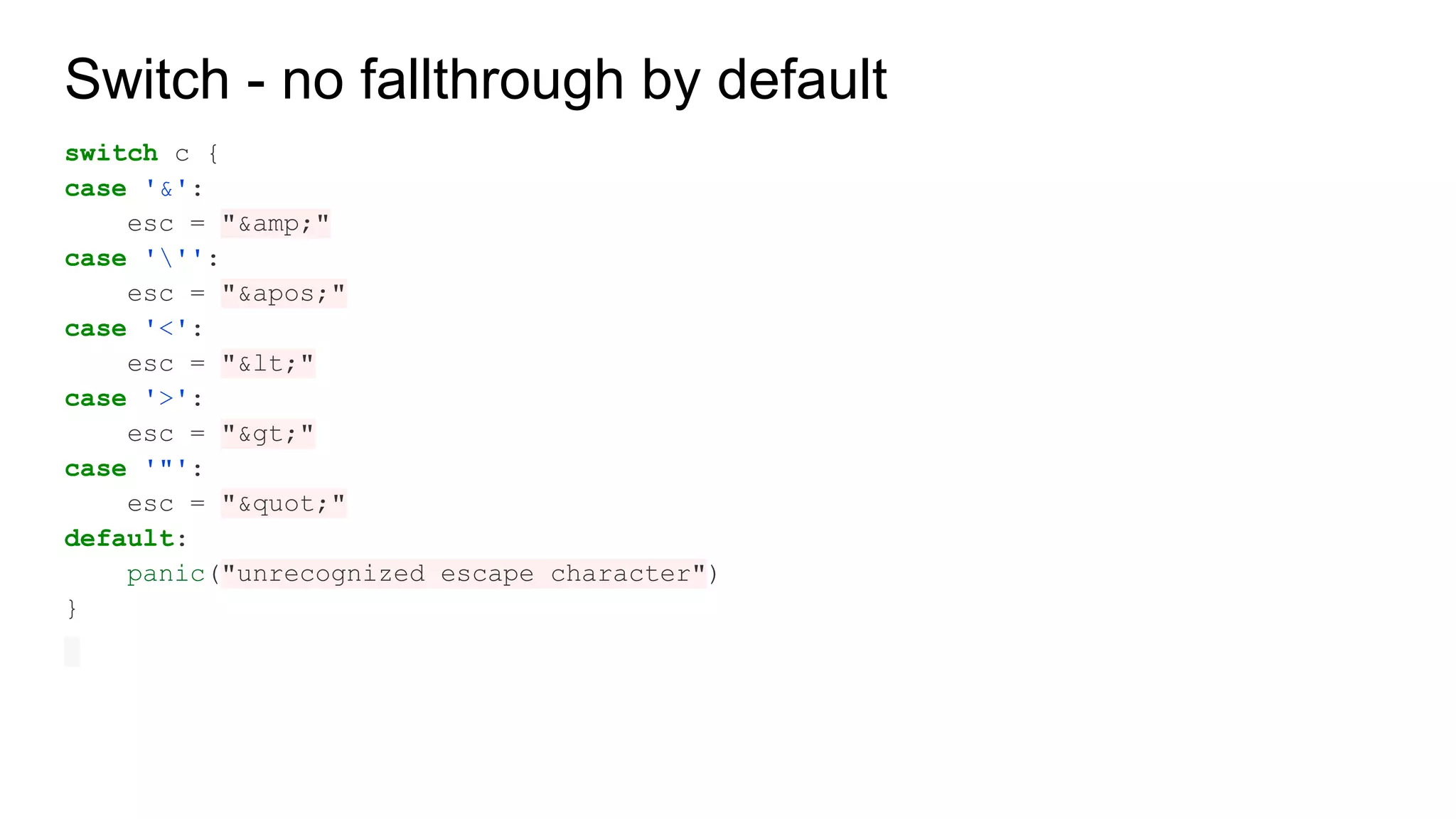
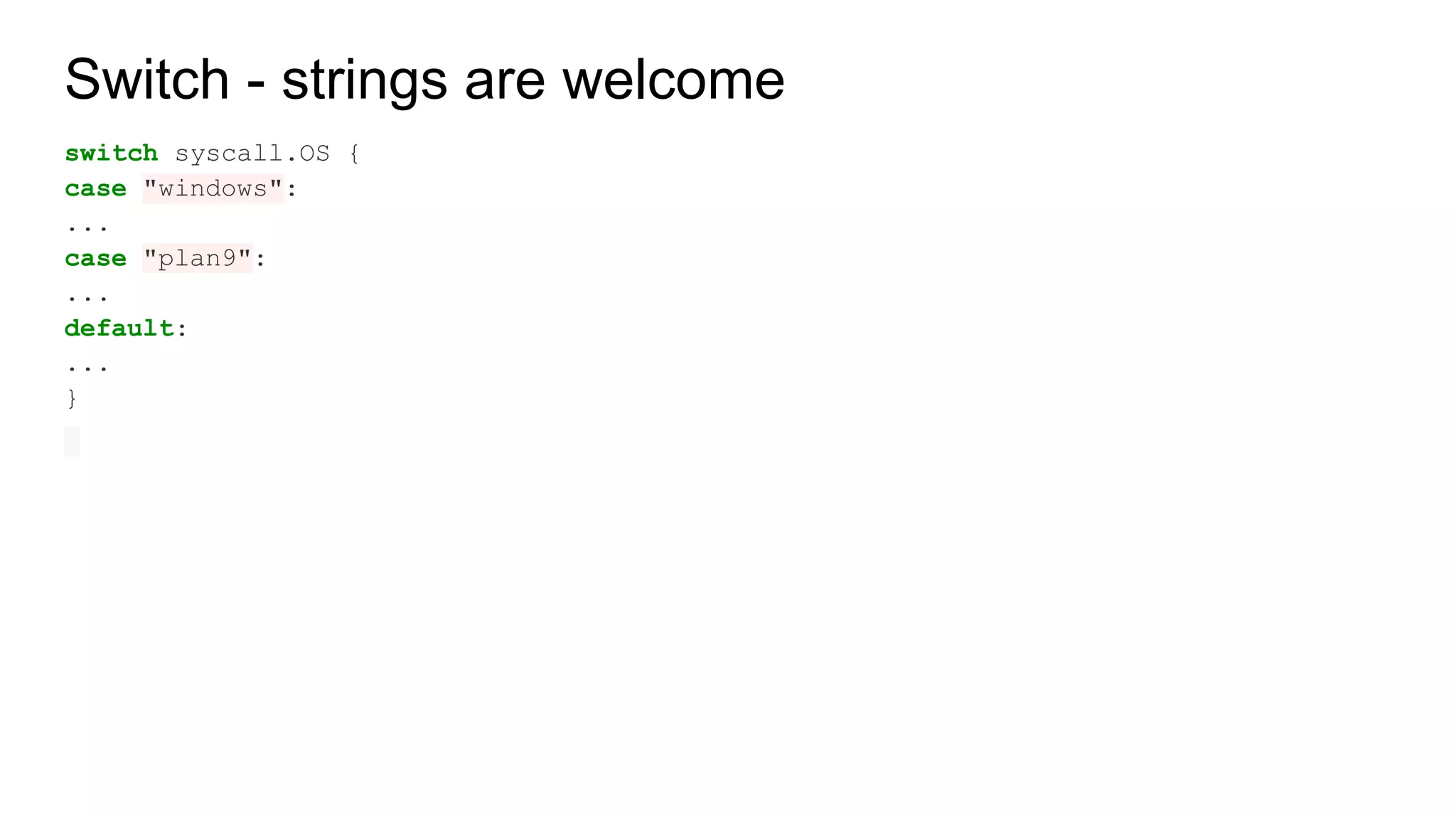
![Switch - (multiple)expression(s) in cases
switch {
case '0' <= c && c <= '9':
return c - '0'
case 'a' <= c && c <= 'f':
return c - 'a' + 10
case 'A' <= c && c <= 'F':
return c - 'A' + 10
}
switch chars[code].category {
case "de", "uk", "fr", "sp", "nl":
return true
}](https://image.slidesharecdn.com/tmcgafnsqhqjc2mdbt5r-signature-31951f50746f53d3c0233ba03f47eb612fb8fe3ac112be702f5d1c13630054c1-poli-160808202001/75/Golang-basics-for-Java-developers-Part-1-47-2048.jpg)
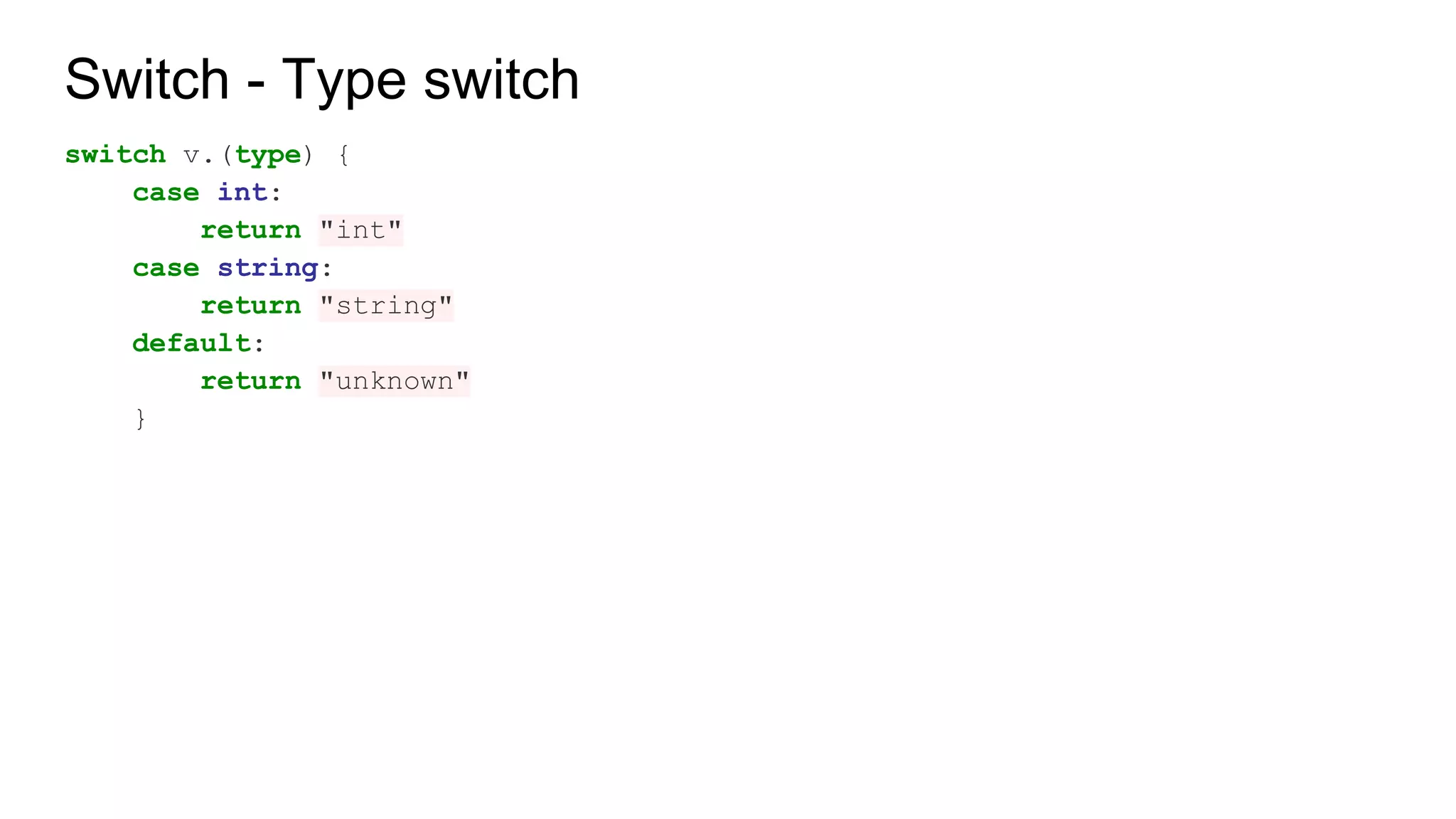
![Switch - you can break it
switch argv[0] {
case "echo":
fmt.Print(argv[1:]...)
case "cat":
if len(argv) <= 1 {
fmt.Println("Usage: cat <filename>")
break
}
PrintFile(argv[1])
default:
fmt.Println("Unknown command; try 'echo' or 'cat'")
}](https://image.slidesharecdn.com/tmcgafnsqhqjc2mdbt5r-signature-31951f50746f53d3c0233ba03f47eb612fb8fe3ac112be702f5d1c13630054c1-poli-160808202001/75/Golang-basics-for-Java-developers-Part-1-49-2048.jpg)
![Switch - fallthrough
switch len(src) {
default:
v |= uint32(src[3])
fallthrough
case 3:
v |= uint32(src[2]) << 8
fallthrough
case 2:
v |= uint32(src[1]) << 16
fallthrough
case 1:
v |= uint32(src[0]) << 24
}](https://image.slidesharecdn.com/tmcgafnsqhqjc2mdbt5r-signature-31951f50746f53d3c0233ba03f47eb612fb8fe3ac112be702f5d1c13630054c1-poli-160808202001/75/Golang-basics-for-Java-developers-Part-1-50-2048.jpg)
